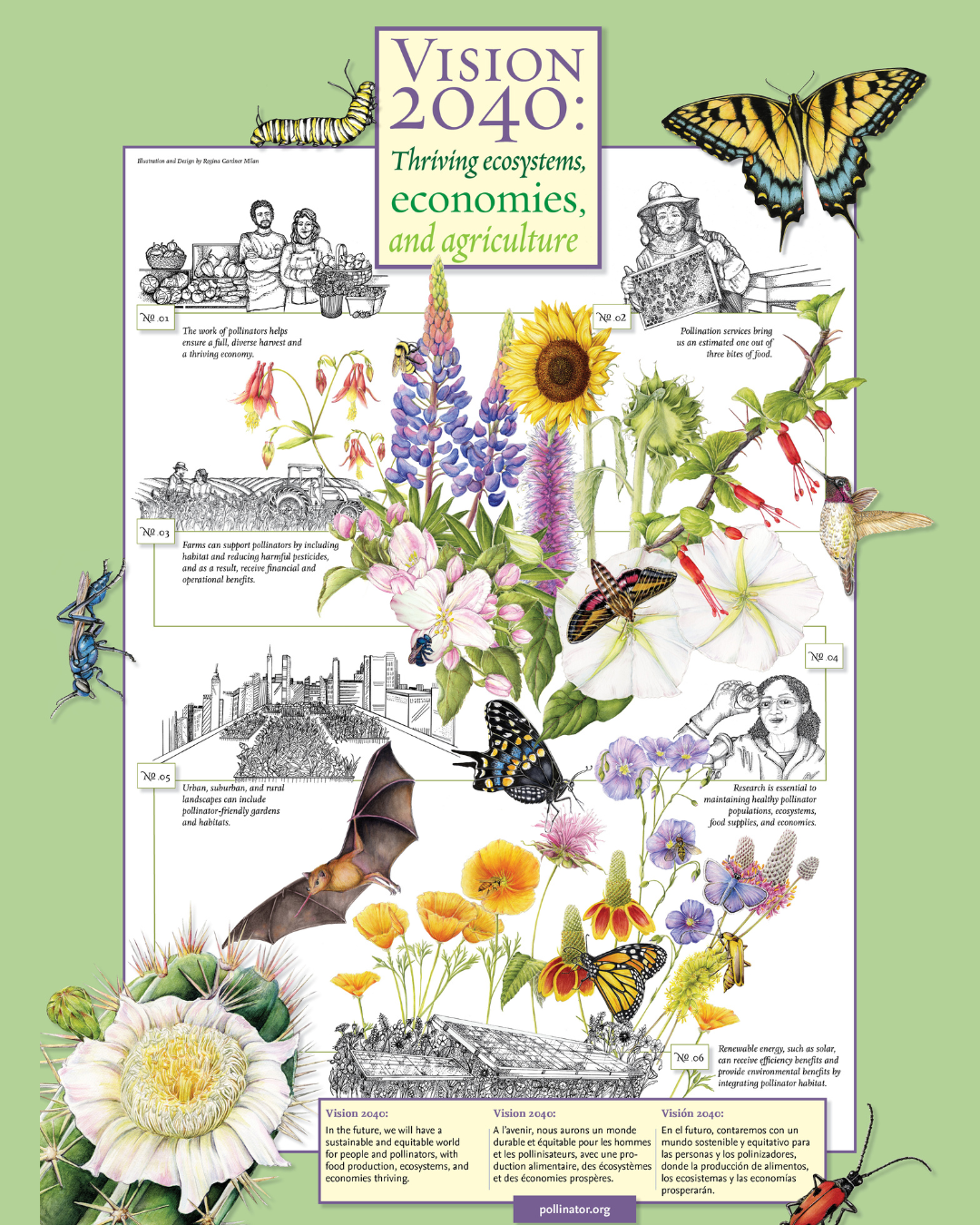Vision 2040: Thriving Ecosystems, Economies, and Agriculture
The moment we've all been waiting for is here! The 2024 Pollinator Poster is now available to order. Created by artist Regina Milan, this poster depicts a vision for where humans and pollinators will be in 2040, with ecosystems, economies, and agriculture thriving. Order yours today!
Poster is 24'' x 36''
Order Posters
Shipping to Canada? Use the payment button below.
About the Artist
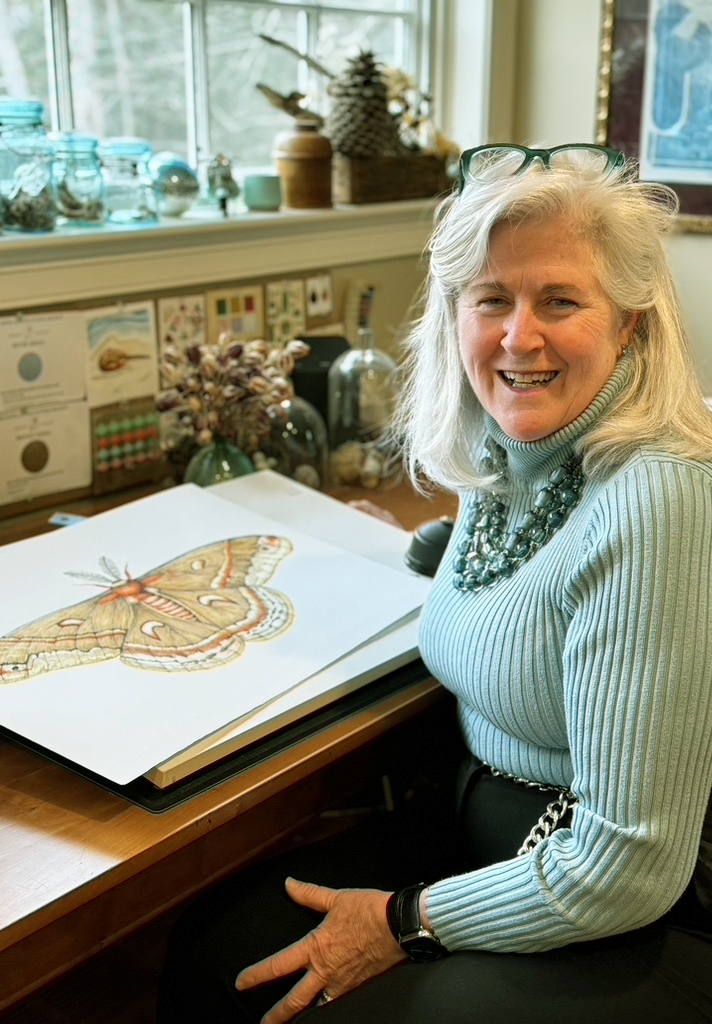
Regina Gardner Milan's journey as an artist began early, nurtured by her mother's encouragement to explore creativity through mediums like watercolors and pastels, often intertwined with family nature walks led by her outdoorsman father. Alongside her twin sister Rita, Regina delved into art classes, spending two high school summers immersed in college-level art studies. She further honed her craft at the University of Massachusetts, Dartmouth, earning a Bachelor of Fine Arts in Visual Design and Illustration, followed by an MFA in Graphic Design from Boston University. Complementing her formal education, Regina pursued a graduate certificate in web and interaction design from UMass Dartmouth and is currently pursuing a Natural Science Illustration Certificate at RISD.
In 1998, Regina founded MILAN concept & design, a graphic design firm, after establishing herself in Boston's advertising scene with stints at Campbell-Ewald and Rapp, Collins, Marcoa. Over her three-decade-long career, she has contributed her creative talents to numerous national accounts, garnering accolades for her work on campaigns for brands like Verizon, Alpha Processor, and Yankee Gas.
In 2003, Regina's artistic horizons expanded when she enrolled in Sarah Roche's botanical illustration class at Wellesley College, a pursuit spurred by her sister Dorothy. This venture into botanical art provided a harmonious counterpoint to her graphic design endeavors, allowing her to flourish as a fine artist. Her dedication to botanical illustration has earned her recognition, including a Certificate of Botanical Illustration with distinction from the Society of Botanical Artists in London, accompanied by the esteemed President's Award. Regina's artwork has graced juried exhibitions worldwide, notably at the Royal Horticulture Society Shows in London, where she secured silver and bronze medals in 2009 and 2014, respectively. She has also held solo exhibitions at esteemed venues such as the Arnold Arboretum of Harvard University and the Cape Cod Museum of Natural History.
In 2020, Regina demonstrated her artistic versatility by illustrating the book "Plant Witchery," showcasing her expertise in botanical illustration alongside her graphic design prowess.
Presently, Regina imparts her knowledge and passion for graphic design as an Associate Teaching Professor at the University of Massachusetts, Lowell, inspiring the next generation of creative minds.
Learn more about Regina at reginamilan.com and follow her on Instagram @milan.artdesign
POSTER PROCESS
Designing the 2024 poster posed a creative challenge, particularly in balancing the incorporation of vast amounts of information with the need for aesthetic appeal. Opting for a black and white approach for the economic aspect of the concept proved instrumental in maintaining the poster's cohesion. Drawing inspiration from various sources enriched the design process immensely. I'm fortunate to have a son deeply involved in organic farming and the solar industry, as well as my own extensive flower gardens. Additionally, at UMASS Lowell, where I teach, we benefit from green roofs and pollinator fields, providing a rich pool of inspiration.
With these elements in mind, I envisioned a composition where intertwining flowers and their pollinators would cut through the design, inviting viewers on a visual journey. Due to the posters size, it was created in multiple pieces and then seamlessly combined using Photoshop. Each of the vibrant color images was painted using watercolor on Fabriano hot press paper.


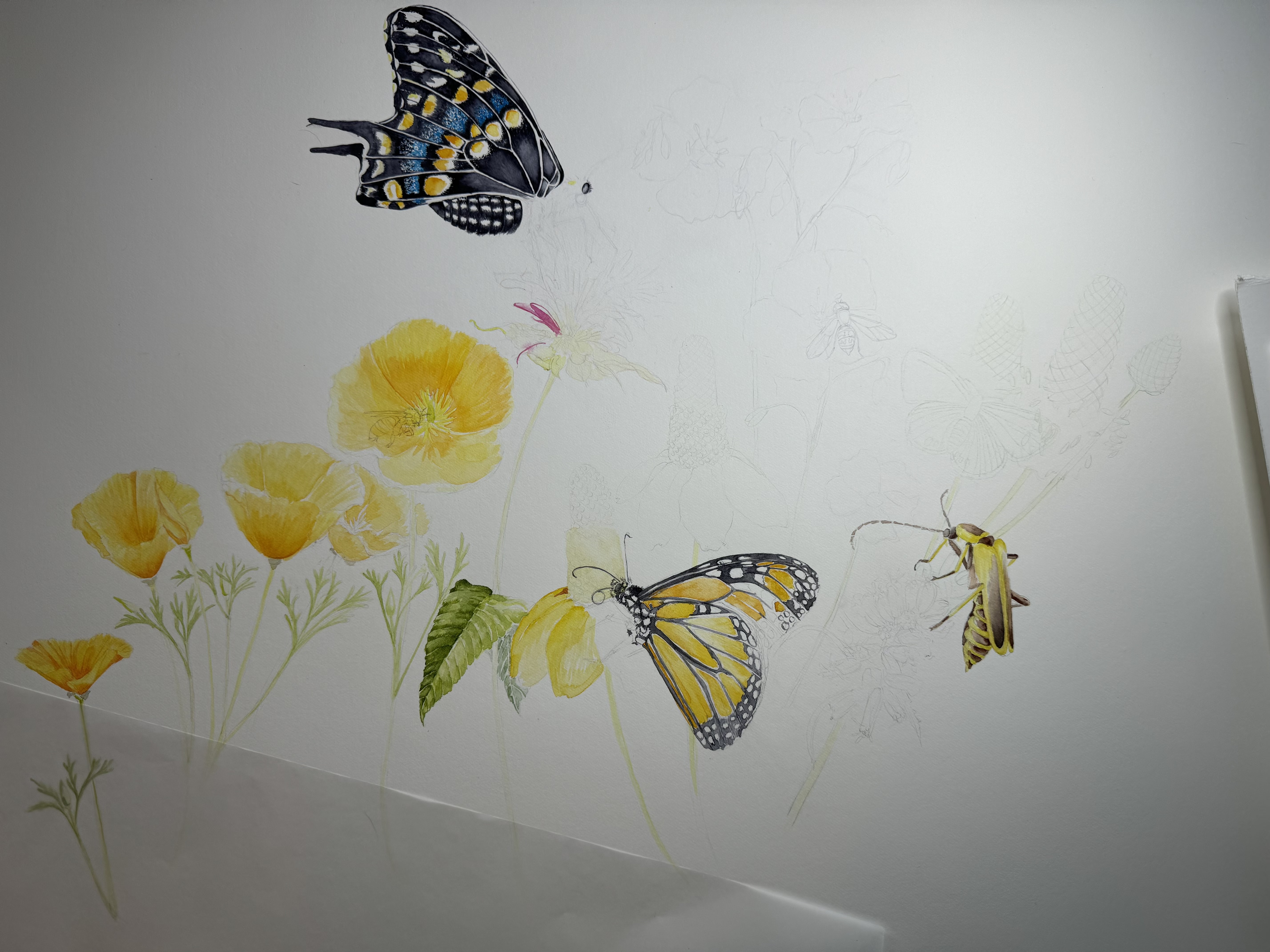
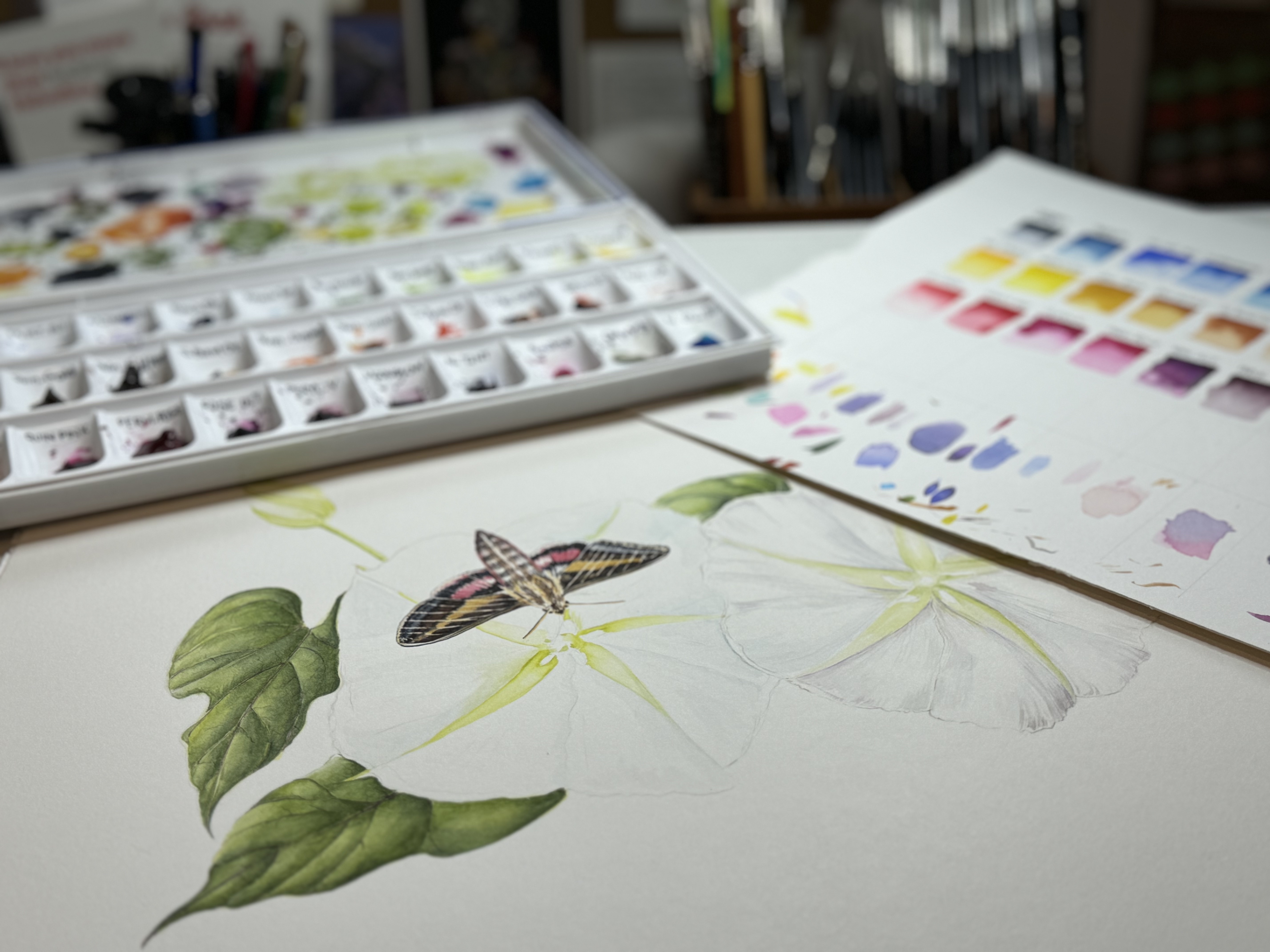
Vision 2040: Thriving Ecosystems, Economies, and Agriculture
POSTER VIGNETTES
One out of every three bites:
Our food systems are deeply intertwined with the health of pollinators. One out of three bites brought to the dinner table is reliant on the ecosystem services that pollinators provide to plants. The genetic material passed along by pollinators allows flowering plants to thrive and produce the natural resources that humans use to feed our communities.
Diverse Harvest & Thriving Economy:
Agriculture is a foundational economic sector for the global economy, and pollinators are major players in creating a diverse and plentiful crop harvest. Annually, pollinators contribute over 200 billion dollars to the global economy and honey bees alone are responsible for 18 15 billion dollars in agricultural productivity in the United States. By investing in pollinators, we are investing in the wellbeing of our global communities.
Farms & Pollinators:
Given the enormous positive impact that pollinators have on agriculture, it is vital that farms take steps to ensure the future preservation of pollinators, which can be done in a variety of ways that are both beneficial for pollinator species as well as for growers. Firstly, farmers can adopt more conservation-focused approaches towards applying pesticides, such as using less of them, applying them only during times of the day when pollinators are less active, and practicing Integrated Pest Management (IPM). Other positive practices include incorporating pollinator habitat, providing clean water sources on farmlands, and utilizing methods such as cover cropping. Not only will farmers ensure a healthy ecosystem for the pollinator by doing this, but they can also save money and have a higher crop yield! Visit our Bee Friendly Farming website to learn more about how farms are a critical part of pollinator conservation.
Green Spaces:
Farmland is not the only space where pollinator-suited habitat can be incorporated for the benefit of both pollinators and humans! The greening of urban and suburban spaces can provide respite for pollinators in land corridors where native plant habitat may be sparse. Communities in populated areas in return can see a reduction in pollution, an increase in flood resistance, as well as protection against the extreme temperature and weather conditions exacerbated by climate change.
Research:
The ever-changing climate presents challenges to the health of pollinators and investing in research is an important part of protecting our interconnected food systems, economies, and ecosystems. Pollinator Partnership and the North American Pollinator Protection Campaign (NAPPC) both dedicate time and resources towards research, such as the Honey Bee Health, Lepidoptera Conservation, and Imperiled Bombus Conservation grants, that better help understand the issues facing pollinators and allow us to take steps to better ensure their resilience.
Clean Energy:
Transitioning to renewable energy, such as solar and wind, is a critical aspect of achieving a clean, thriving future! Projects that develop land for the purpose of establishing renewable energy infrastructure are rapidly growing, and present an opportunity to benefit pollinators simultaneously. Solar farms, as well as rights-of-way and land utilized for the transmission of electricity, provide ample space to use as habitat for pollinators. The path towards developing a more sustainable world, done mindfully, can lead to a more symbiotic relationship between humans, pollinators, and the natural environment.
Plant / pollinator pairings on this year's poster:
Fuchsia-flowered gooseberry (Ribes speciosum) and Anna’s Hummingbird (Calypte anna)
Photo by Stan Shebs, courtesy of Wikimedia Commons CC BY 3.0
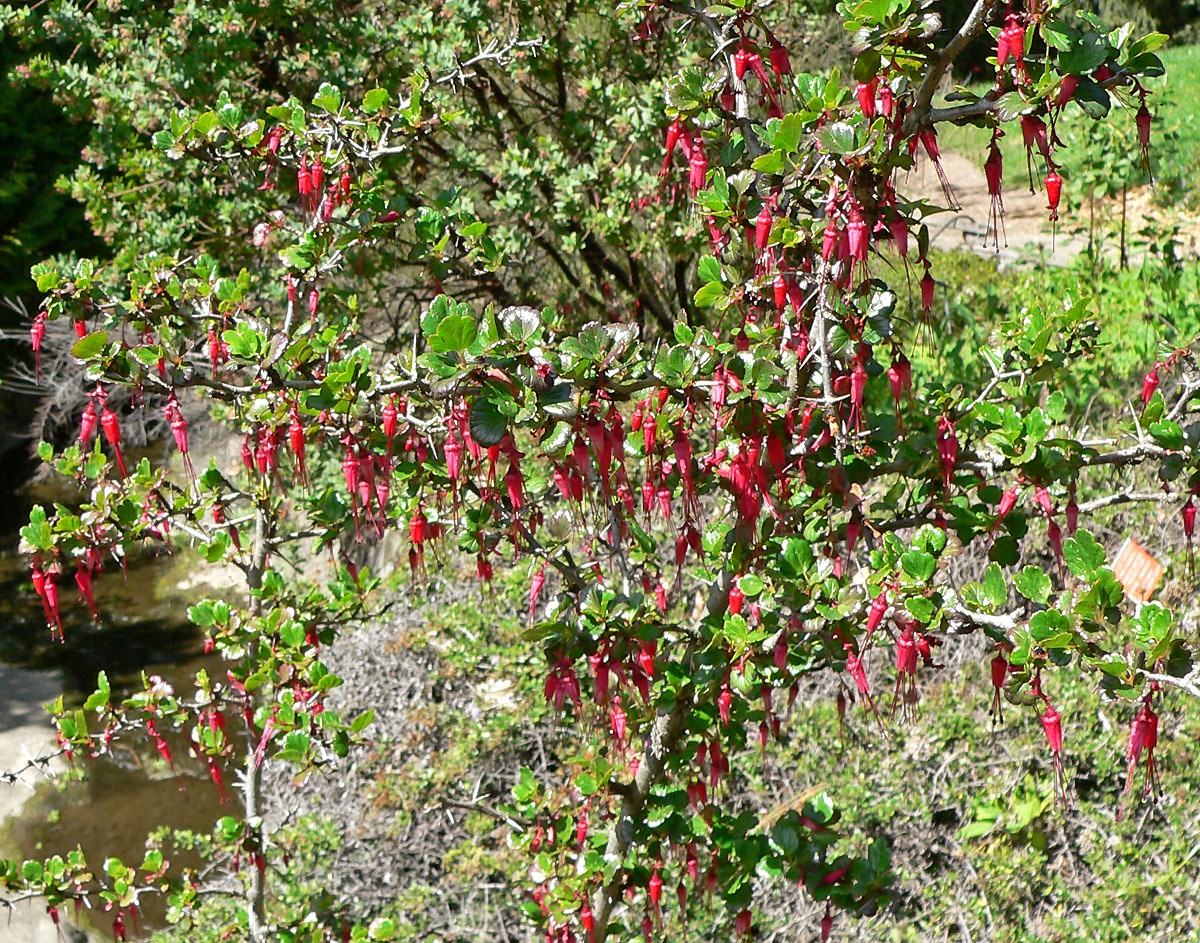
Fuchsia-flowered gooseberry (Ribes speciosum):
A California-native shrub that thrives in coastal areas such as the San Francisco Bay Area, the Fuchsia-flowered Gooseberry tends to prefer shaded areas, but has been known to survive in full sun exposure in certain regions. Despite their beautiful red flowers and their edible berries, these shrubs should be approached with caution given that they utilize an abundance of thorns hiding underneath their leaves. Native Californians, such as the Luiseño tribe, would use long sticks and place baskets underneath the gooseberry bushes, knocking the berries down into the baskets. The remaining thorns and prickles would be rubbed off or burnt using hot coals. The Fuchsia-flowered Gooseberry maintains a mutualistic relationship with hummingbirds, attracting them with the red pigment in their leaves, providing an energy source for the birds, while also being pollinated.
https://calscape.org/Ribes-spe...(Fuchsiaflower-Gooseberry)
Photo by David Hofmann, courtesy of Flickr CC BY 2.0
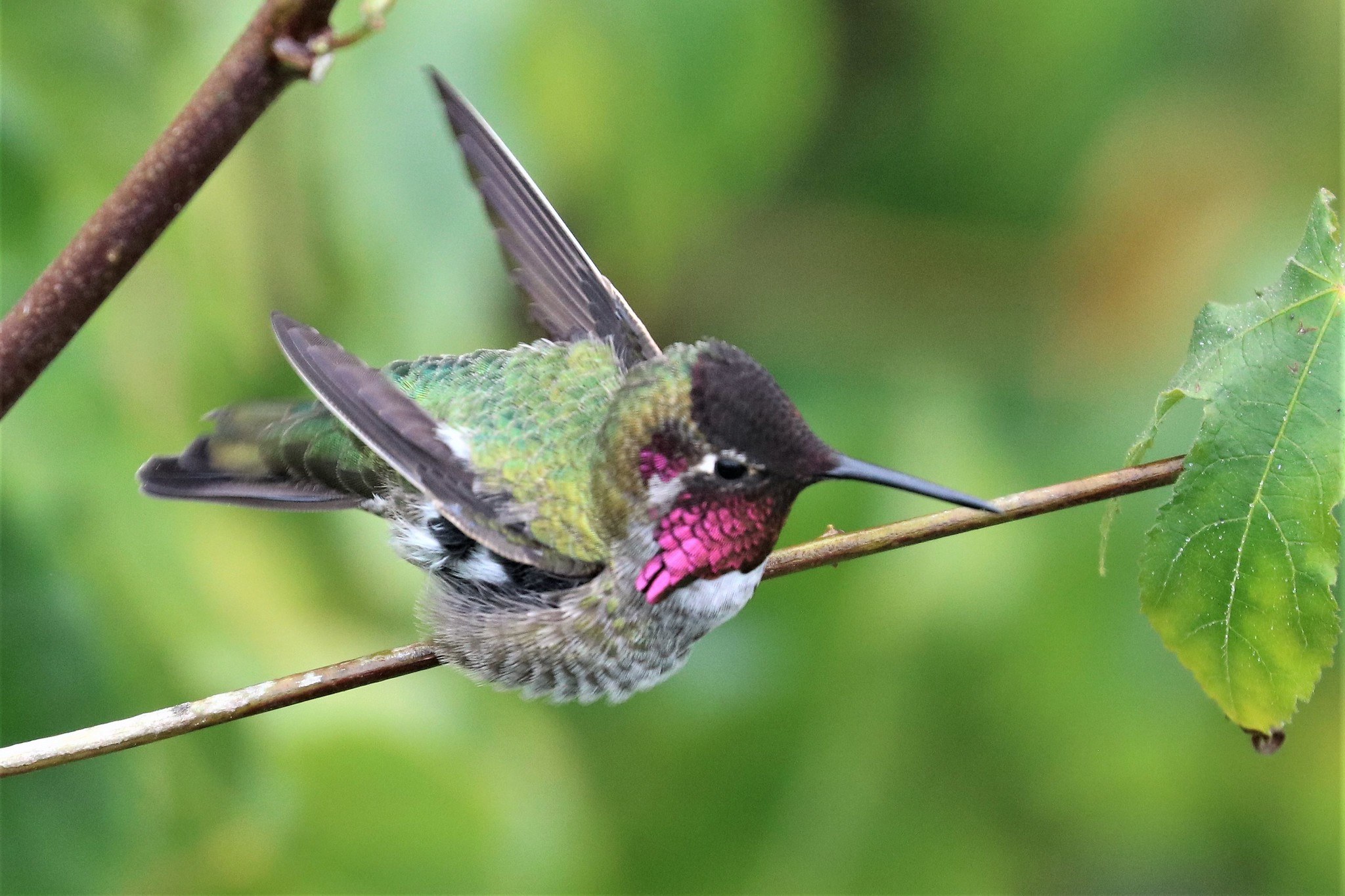
Anna’s Hummingbird (Calypte anna):
A frequent visitor to sugar water feeders across the southwestern United States, Anna’s hummingbird is one of the most common hummingbird species in the region; they can also be found throughout the Pacific Northwest, Alaska, and southern Canada. Sporting a predominantly green and gray color scheme, you can identify the males apart from the females by their bright maroon throat patch. Their long straight bills allow them to extract nectar from the long, tubular, red, orange, and yellow flowers that they visit. Small insects also are on the menu for the Anna hummingbird, as they provide an important source of protein and lipids. One major distinction between this species of hummingbird and the rest is their mating pattern includes singing! In a display of courtship, the males will sing, and then dive down through the air, only to quickly pull up to create a popping noise with their wings.
https://www.fs.usda.gov/wildflowers/pollinators/pollinator-of-the-month/calypte_anna.shtml
Tall goldenrod (Solidago altissima) and Goldenrod Soldier Beetle (Chauliognathus pensylvanicus)
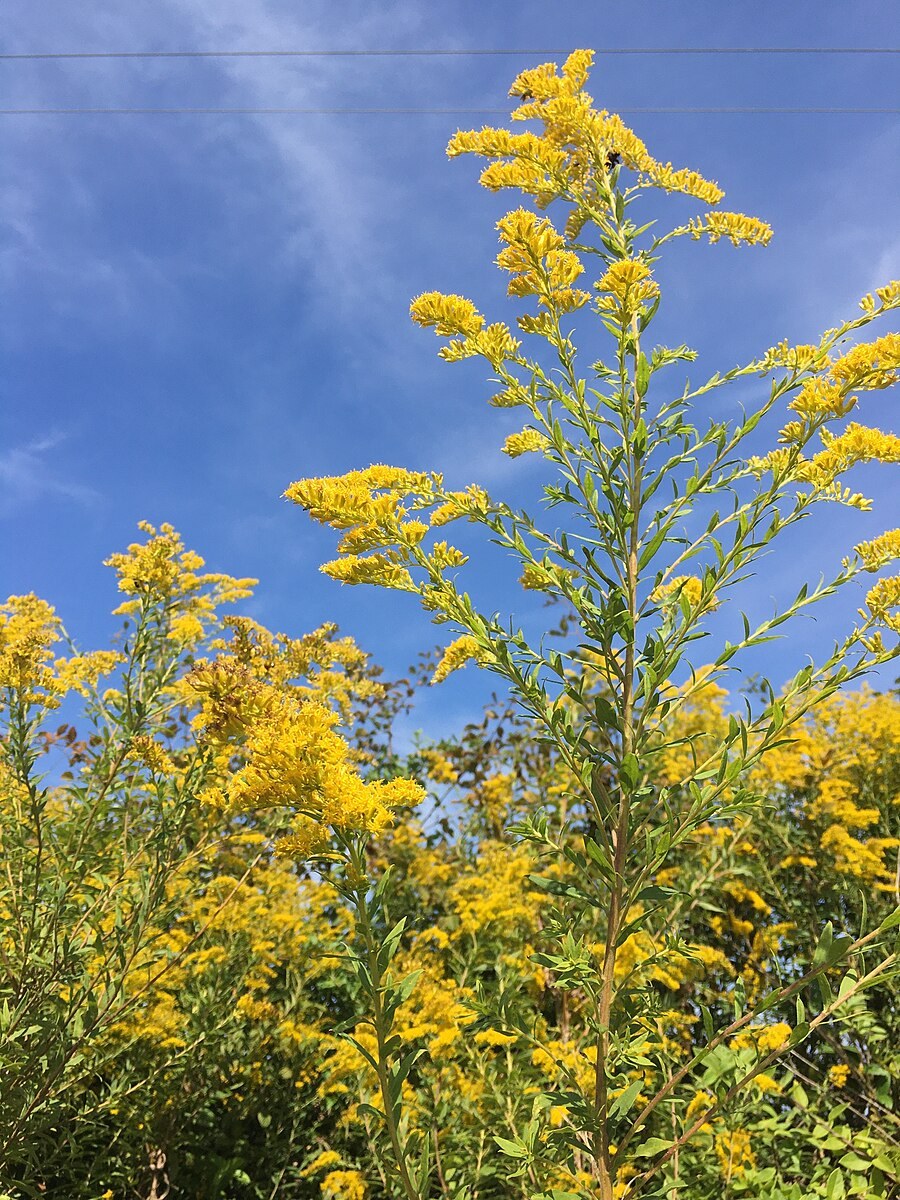
Tall goldenrod (Solidago altissima):
Tall goldenrod is a perennial herb that can grow up to six feet tall and features yellow blooms and yellowish-green leaves. It can be found throughout the United States and Canada, and has a native distribution in Louisiana, California, Virginia, Alaska, and southern Canada. Preferring sun or partial shade, moist to dry soil types, and a moderate amount of water, Tall Goldenrod finds its habitats near roadsides, prairies, and open woods. They attract a range of pollinators including native bees, honey bees, birds, and butterflies.
https://www.wildflower.org/plants/result.php?id_plant=soal6
Photo by Judy Gallagher, courtesy of Wikimedia Commons CC BY 2.0

Goldenrod Soldier Beetle (Chauliognathus pensylvanicus):
Goldenrod Soldier Beetles, also known as Pennsylvania leatherwing, are abundant in the midwest United States, and can be found all throughout North America. These beetles commonly visit goldenrod, Queen Anne’s Lace, milkweed species, prairie onions, and are especially drawn to yellow flowering plants. Along with feasting on nectar and pollen, they also eat aphids, caterpillars, and other small insects. Similarly resembling fireflies, the goldenrod soldier beetle has orange wings with black spots, with long antennae. The soldier beetle’s presence can provide even more benefit for plants than just pollination, as they feed on pests and parasites.
https://content.ces.ncsu.edu/goldenrod-soldier-beetle
https://hort.extension.wisc.edu/articles/goldenrod-soldier-beetle/
https://www.inaturalist.org/taxa/216649-Chauliognathus-pensylvanicus
Purple prairie clover (Dalea purpurea) and Reakirt’s blue butterflies (Hemiargus isola)
Photo courtesy of USFWS, CC BY 2.0
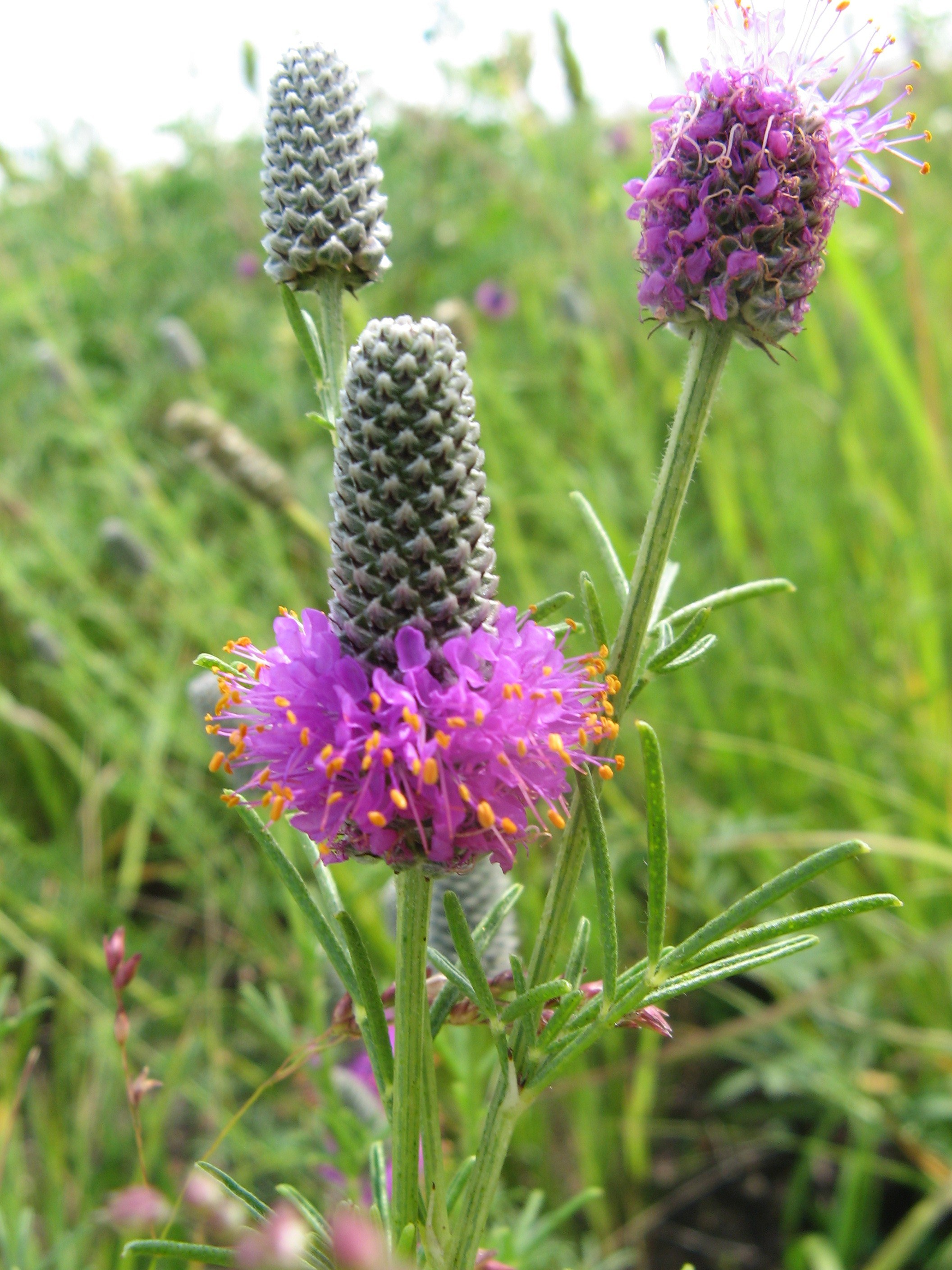
Purple prairie clover (Dalea purpurea):
The Purple prairie clover is a perennial subshrub and legume that is found across North America, native to prairies and dry hills of the midwestern, central, and southern states, as well as parts of Canada. One of the most common of the prairie clover species, they can be identified by their cone-shaped purple heads. Numerous benefits are derived from the presence of this legume, including them being an excellent source of protein and nutrition for wildlife, having a high resiliency in the face of invasive species, nitrogen-fixing properties, as well as medicinal benefits for humans. Pollinators also greatly benefit from the purple prairie clover, attracting native and honeybees, as well as butterflies.
https://plants.usda.gov/home/plantProfile?symbol=dapu5
https://www.wildflower.org/plants/result.php?id_plant=dapu5
Photo by Bryan, courtesy of iNaturalist CC BY 4.0
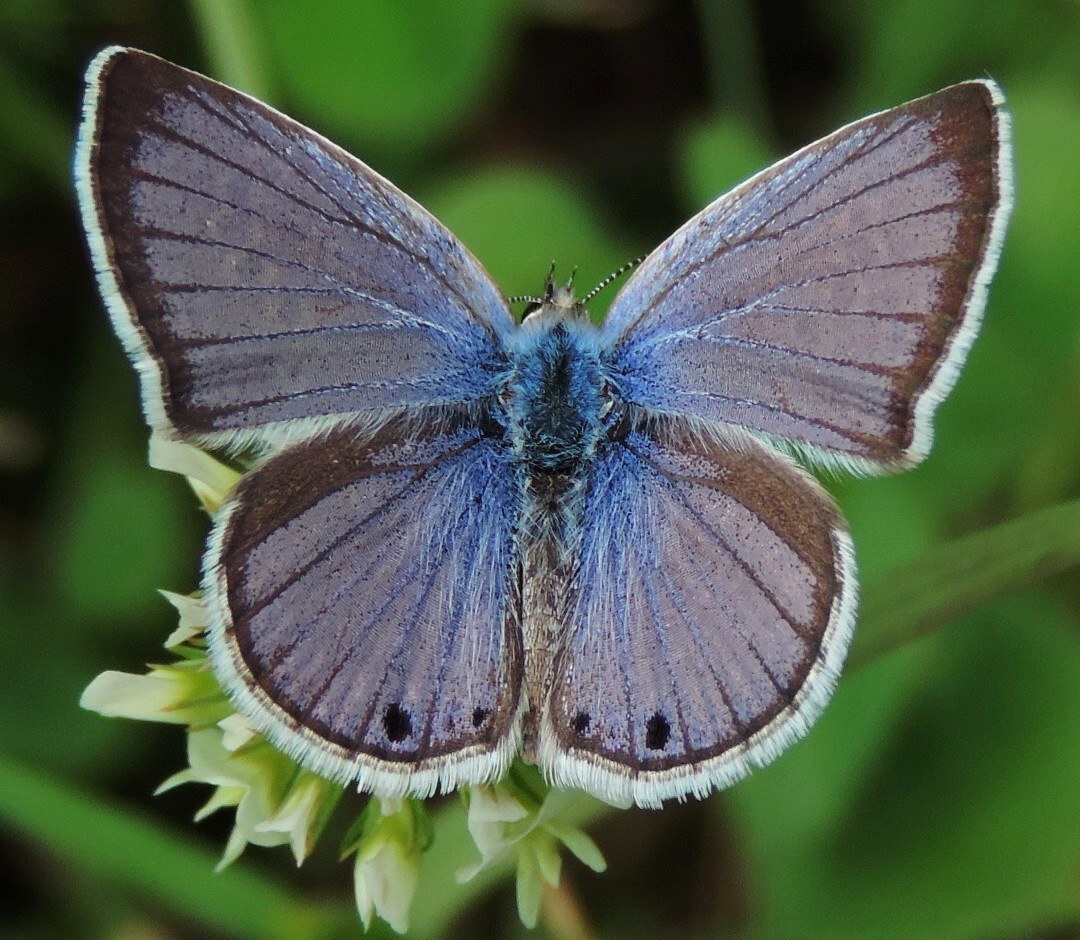
Reakirt’s blue butterflies (Hemiargus isola):
Found in an expansive range from Costa Rica all the way to the U.S - Canadian border, Reakirt’s blue is a species of butterfly whose geographic span speaks to their versatility and resilience. Their habitats include deserts, grasslands, meadows, creeksides, and areas with a predominance of weeds. Common sources of food for the butterfly are plants such as spearmint, various clover species, and alfalfa. The male Reakirt’s blue has blue upper wings, while the females can be identified by their brown wings and blue shading closer to their body. Both males and females feature black spots on the hindwing and underside of the wing.
Blue Orchard Mason Bee (Osmia lignaria) and McIntosh Apple Flowers (Malus domestica 'McIntosh')
Photo by Robert Engelhardt, courtesy of Wikimedia Commons CC BY 3.0
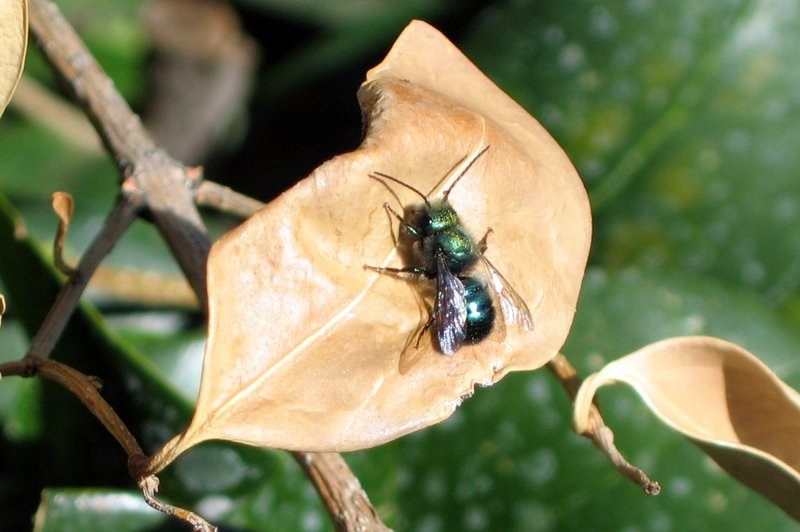
Blue Orchard Mason Bee (Osmia lignaria):
While honey bees are extremely utilized in the commercial agriculture industry due to their specialization, mason bees are similarly effective in their pollination of native plants and crops. The blue orchard mason bee, one of over a hundred mason bee species native to North America, is crucial for the pollination of fruit trees such as pears, apples, almonds, and peaches, so much so that farmers have regularly managed the bees by creating makeshift nests near and even in the trees themselves. A solitary bee, they can be identified by their blue, metallic bodies, as well their technique of carrying pollen on their bellies, dissimilarly from honey bees which carry pollen behind their hind legs.
https://www.fs.usda.gov/wildflowers/pollinators/pollinator-of-the-month/mason_bees.shtml
Photo by Liz West, courtesy of Flickr CC BY 2.0
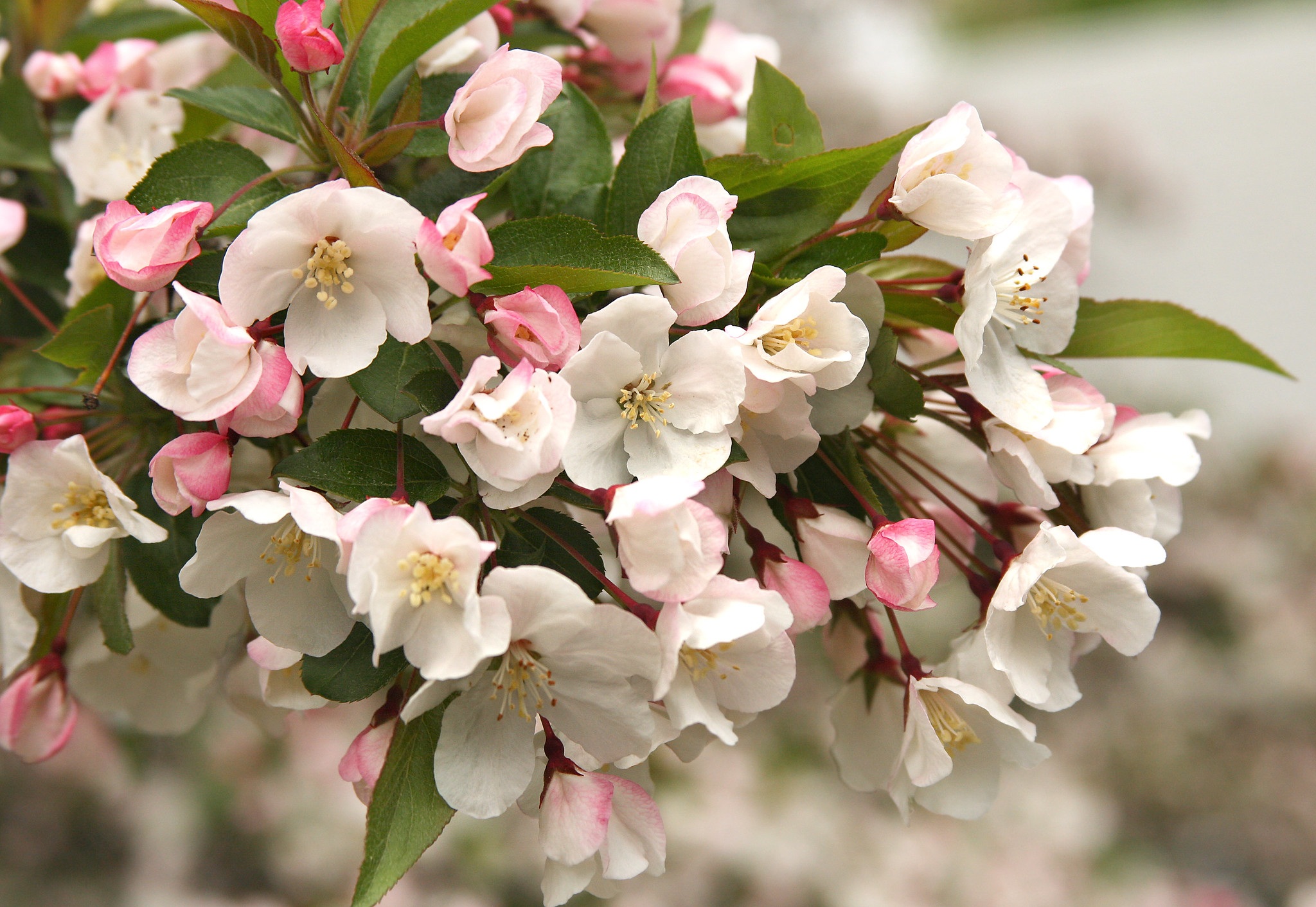
McIntosh Apple Flowers (Malus domestica 'McIntosh'):
Along with delicious fruit that’s great for fresh eating, sauces, and juicing, McIntosh Apple tree produces copious amounts of clustered, sweet-smelling white flowers that will attract a variety of pollinators when they bloom in mid-spring. This year’s poster depicts a blue mason bee visiting one of its flowers. These trees require are most appropriate for planting in USDA Hardiness zones 3-7, and prefer full sun and moist, well-draining soil. To produce fruit, the McIntosh Apple tree needs 900 chill hours (hours where the temperature is below 45°F), and for best results, a pollinizer apple tree like Granny Smith or Red Delicious should be planted as close to possible to the McIntosh.
https://kb.jniplants.com/mcintosh-apple-malus-domestica
White-lined sphinx moth (Hyles lineata) and Moonvine (Ipomoea alba)
Photo courtesy of USFWS
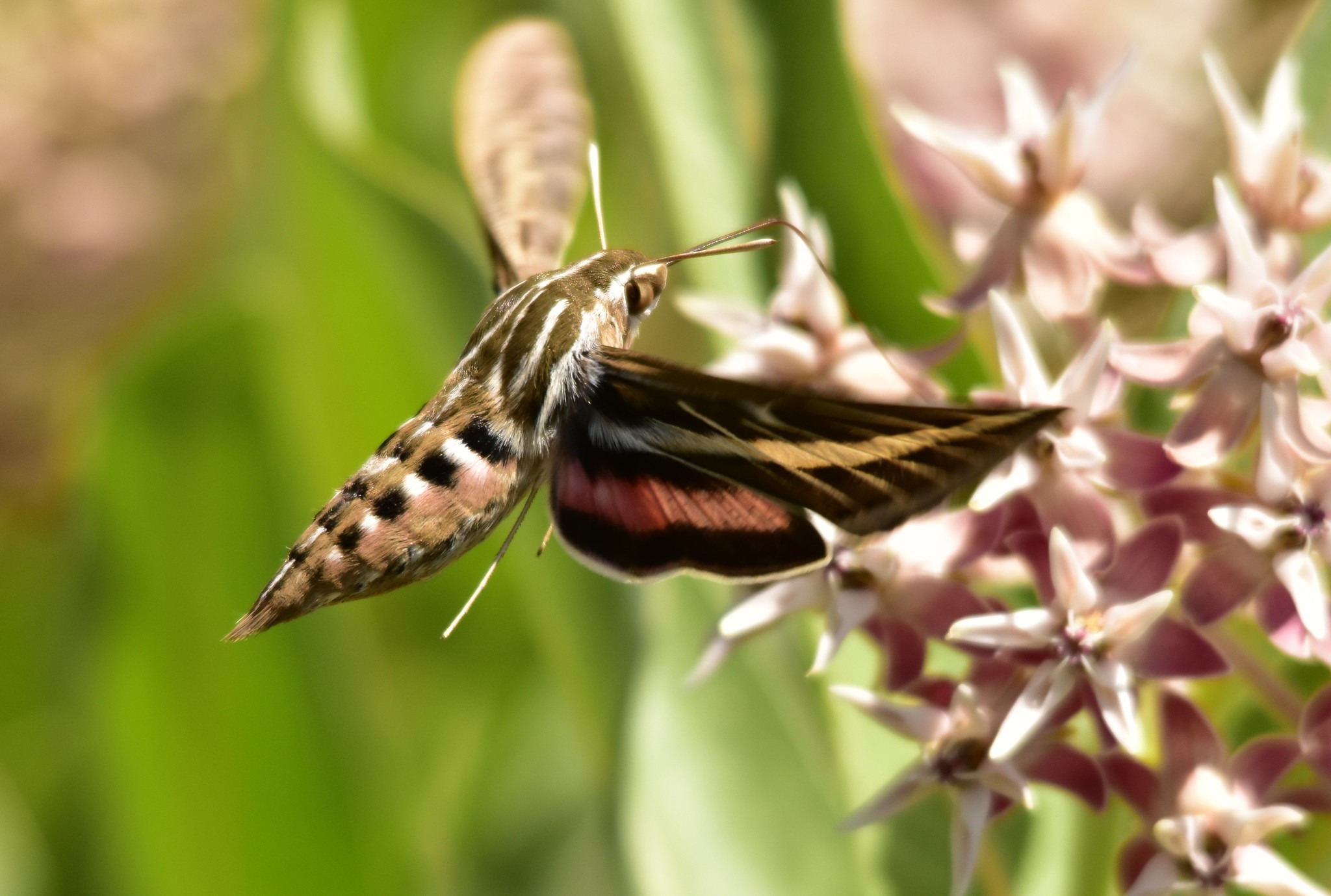
White-lined sphinx moth (Hyles lineata):
Primarily a nocturnal flier but also can be seen during the day, the white-lined sphinx moth (Hyles lineata) is a prolific species and lives in most of the United States, southern Canada, Central America, and Mexico. The white-lined sphinx moth is characterized by its large, furry brown body, olive-colored wings with thin white stripes, and pink hindwings. The large body of H. lineata requires rapid wing beating to stay suspended. The high-speed wing movement often results in H. lineata being mistaken for a hummingbird. Females lay hundreds of eggs in the spring and at least two generations are born annually. During the pupal stage, the larvae burrow into the soil for 2-3 weeks before emerging as adults. The pupae wiggle towards the surface of the soil to easily emerge as moths. The caterpillars have a yellow or orange pointed horn with a black tip allowing them to blend in with their host plant.
https://hort.extension.wisc.edu/articles/white-lined-sphinx-moth-hyles-lineata/
http://arizonabeetlesbugsbirdsandmore.blogspot.com/2011/07/last-night-arizona-queen-of-night.html
https://www.nps.gov/cabr/blogs/species-spotlight-white-lined-sphinx-moth-hyles-lineata.htm
https://www.sphingidae.us/hyles-lineata.html
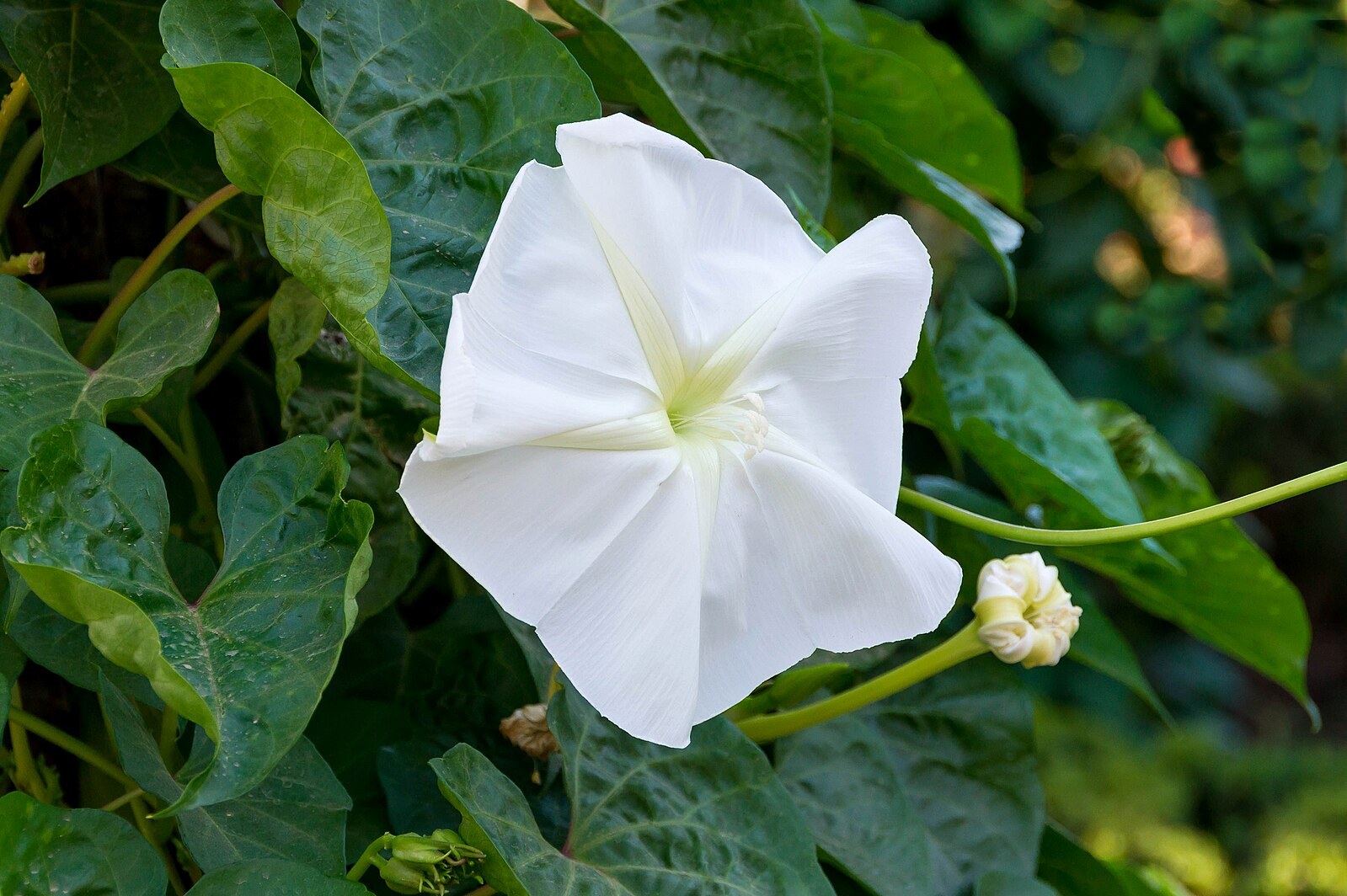
Moonvine (Ipomoea alba):
In the morning glory family, moonvine is an annual flower commonly grown in North Carolina as an annual, and native to Central and South America, as well as Florida and Mexico. If provided their preferred conditions of clay, loam, or sandy soil types, and plenty of sun exposure, moonvines can grow to a height of 15 feet and a width of 6 feet. One of these morning glory vine’s most spectacular qualities are their nocturnal blooms, a stunning white flower that begins to open in the evenings, fully displayed during the nighttime, and subsequently recedes come morning. This nightly flowering is primarily taken advantage of by moths and some specialized bees, who enjoy the more exclusive pollination window. While the moonvine is a gorgeous plant, it is important to note that it can be poisonous to humans if ingested!
https://plants.ces.ncsu.edu/plants/ipomoea-alba/
Mexican Long-Tongued Bat (Choeronycteris mexicana) and Saguaro Cactus (Carnegiea gigantea)
Photo courtesy of Steve Buchmann, Pollinator Partnership
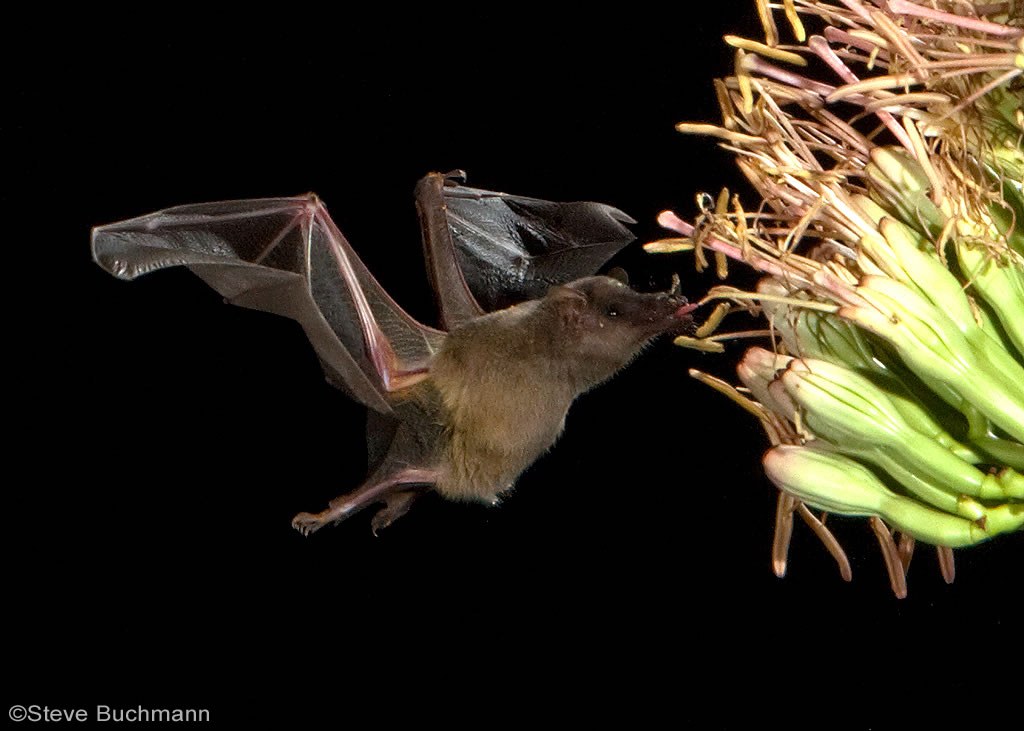
Mexican Long-Tongued Bat (Choeronycteris mexicana):
The Mexican long-tongued bat is a species of bat that resides in northern Central America, Mexico and the southwestern United States, primarily in the states of New Mexico, Texas, California, and Arizona. Mexico is the location of the species’ roosting dwellings, where the bats typically live in caves, mines, buildings, etc. Following a migratory path that traces blooms of agave and cactuses, they are found north in the summer months and travel south when the weather turns cold. They feature a grayish-brown fur coat, and a leaf-shaped nose that they use for ultrasonic echolocation that they shout through their nostrils.
https://www.pollinator.org/pollinator.org/assets/generalFiles/NAPPC.Bats.broch.8.5x11.ver3.pdf
Photo by Stan Shebs, courtesy of Wikimedia Commons, CC BY 3.0
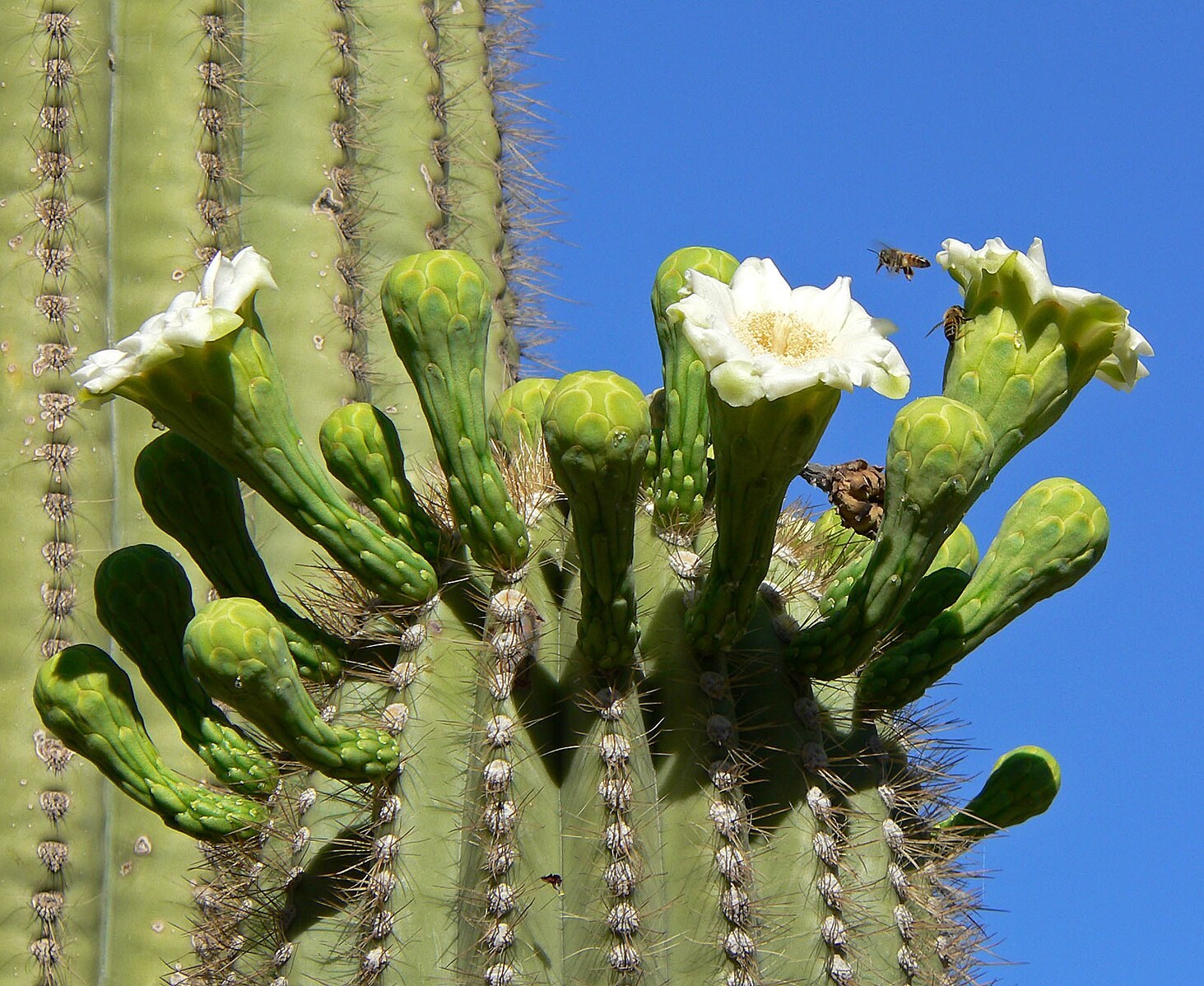
Saguaro Cactus (Carnegiea gigantea):
The saguaro cactus is a large cactus native to the Sonoran desert of the Southwestern United States and Mexico. It can live 150-250 years, grow up to 50 ft. tall, and weigh up to 9 tons. The cactus provides important perching and nesting sites for Red-tailed Hawks (Buteo jamaicensis); and nesting cavities for other birds including gilded flickers (Colaptes chrysoides), Gila woodpeckers (Melanerpes uropygialis), elf owls (Micrathene whitneyi), and purple martins (Progne subis). It also provides nectar for species of migrating bats such as lesser long-nosed bats (Leptonycteris curasoae yerbabuena) and Mexican long-tongued bats (Choeronycteris mexicana), and diurnal creatures like wasps, bees, butterflies, and birds during the brief periods each morning the cactus flowers bloom before closing in the afternoon sun. It produces fruit that is common sustenance for many desert dwelling animals.
https://www.desertmuseum.org/kids/oz/long-fact-sheets/Flowers%20and%20Fruit.php
https://www.desertmuseum.org/kids/oz/long-fact-sheets/Saguaro%20Cactus.php
Mexican hat (Ratibida columnifera) and Monarch butterfly (Danaus plexippus)
Photo by NMSU IPM, courtesy of Flickr CC BY 2.0
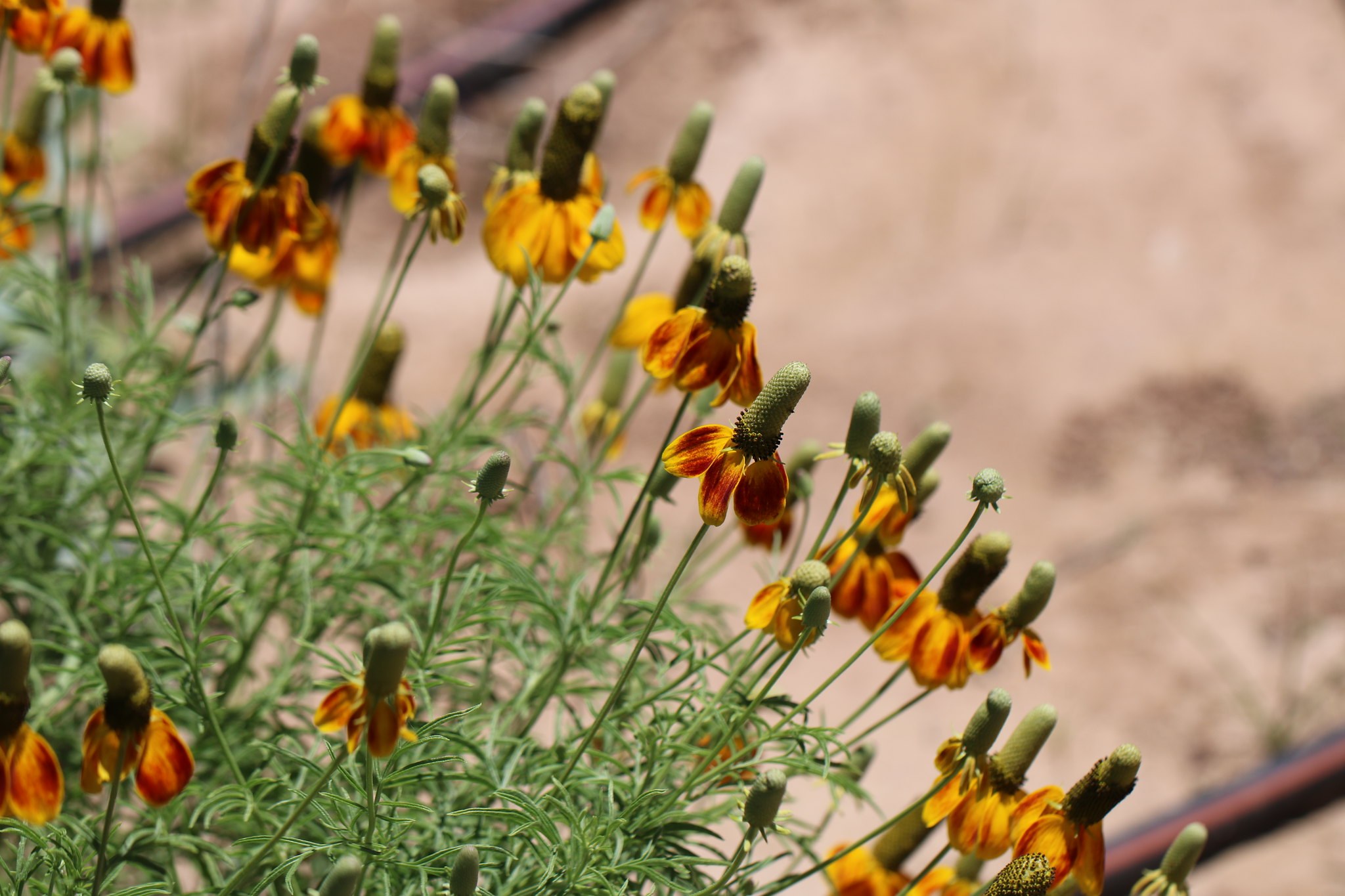
Mexican hat (Ratibida columnifera):
Mexican hat or upright prairie coneflower is an eye-catching and easy-to-grow clumping perennial, with yellow and reddish brown flowers dropping around a long central disc. This hardy and fast-growing plant is suitable for gardens across the US aside from the Northeast, and blooms annually from May - October. They prefer full sun, well-draining soils, and attract a variety of native bees, butterflies, and other insects. Try growing them from seed and watch as they come up year after year - Mexican hat will self-sow their own seeds.
https://www.wildflower.org/plants/result.php?id_plant=raco3
https://www.npsot.org/posts/deep-dive-mexican-hat-courtesy-lady-bird-johnson-wildflower-center/
Photo by Anthony Colangelo, Pollinator Partnership
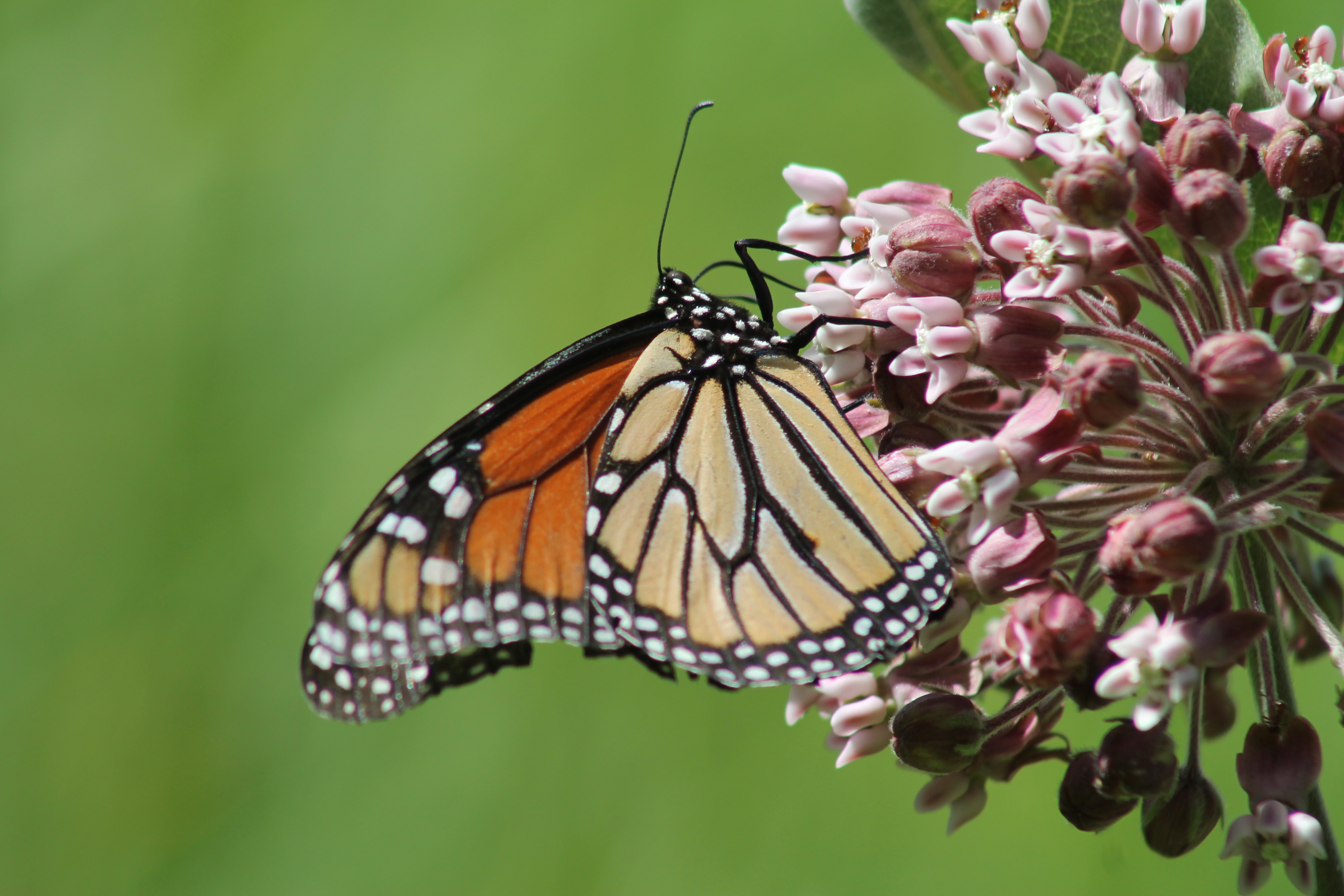
Monarch butterfly (Danaus plexippus):
The Monarch butterfly (Danaus plexippus) is perhaps the most well-known butterfly in North America, recognizable by its bright orange wings with black borders, black veins, and white dots along the edges. Monarchs are full of endurance, traveling by the millions from Canada and the northern U.S. to thousands of miles away in central Mexico and the California coast for their overwintering sites. Despite this feat of migration, monarchs are declining, most likely due to loss of habitat, loss of milkweed, and drought conditions in California, among other factors. Both the Monarch caterpillar and adult butterfly rely on milkweeds (Asclepias spp.) [pictured] as a food source. Milkweeds also contain a toxin that caterpillars accumulate in their bodies and lasts into adulthood, making them bad-tasting to predators and helping them survive. Most of the monarchs that join the migration each fall are three or four generations removed from the previous year- how monarchs navigate to the same groves of trees visited by their ancestors remains an unsolved scientific mystery!
https://www.pollinator.org/monarch
https://www.pollinator.org/pollinator.org/assets/generalFiles/NAPPC.Monarch.broch.Aug.2019.hRes.pdf
https://www.butterfliesandmoths.org/species/Danaus-plexippus
Syrphid Fly (Syprhidae spp.) and Blue flax (Linum lewisii)
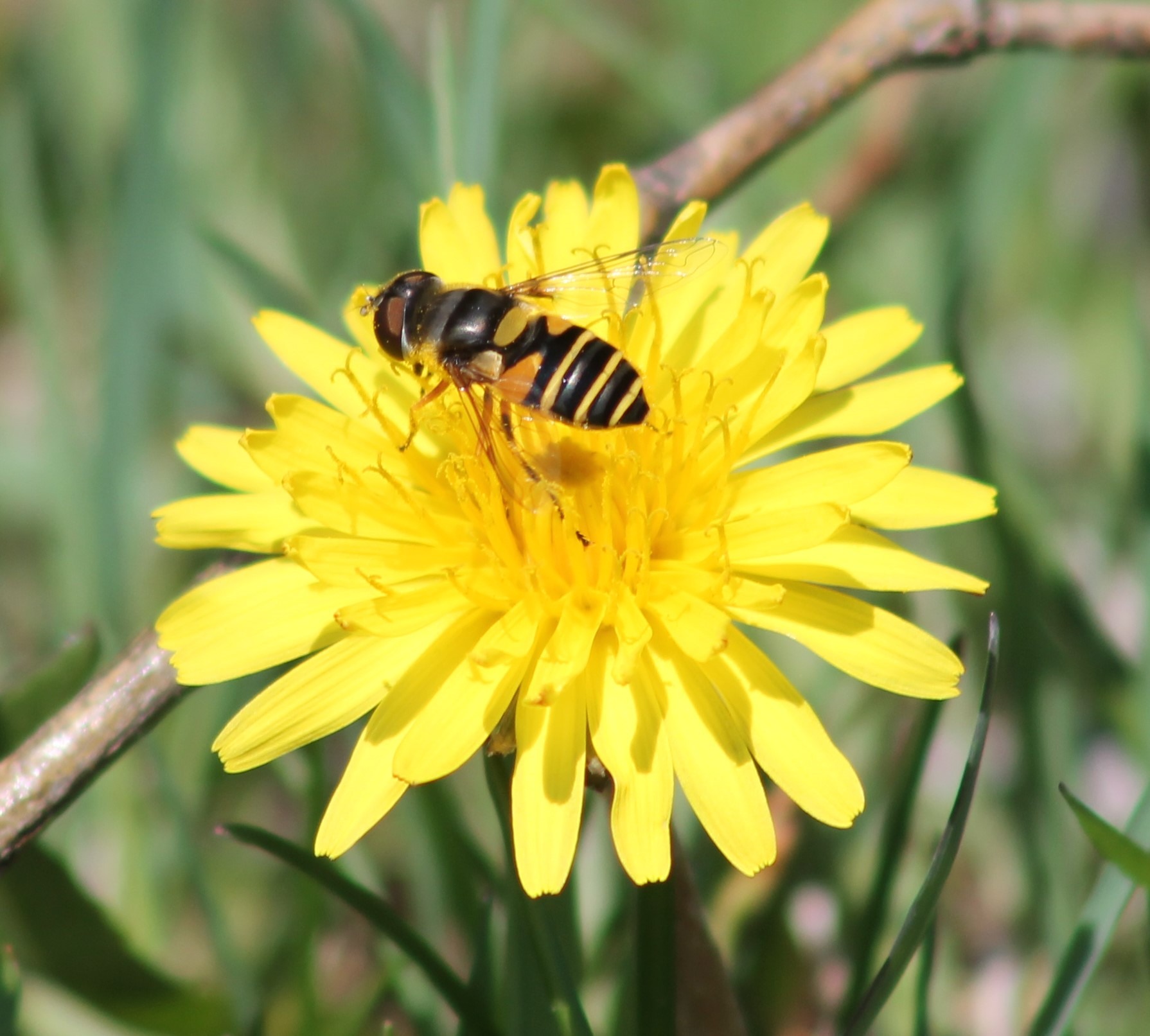
Syrphid Fly (Syprhidae spp.):
Syrphid or hover flies (Syprhidae spp.) are among the most frequent flower visitors, making them important pollinators here in North America. Of the 900 different species of syrphid flies that have been documented across the continent, most of them bear the conspicuous yellow and black markings, as is the case with the syrphid fly depicted in this year’s poster. This coloration acts as a deterrence mechanism for predators like birds and lizards, leading them to potentially mistake the syrphid fly as a stinging bee. Along with their large eyes, single pair of translucent wings, and short, small bodies, syrphid flies can also be recognized by their distinct flight pattern, which involves the fly hovering and then quickly changing direction. Syrphid flies are known to pollinate different kinds of flowers, including violets (Viola), thistles (Cirsium), and orchids (Epipactis), and have been documented as predators of common garden pests like aphids, scales, and other soft-bodied insects.
https://www.fs.usda.gov/wildflowers/pollinators/pollinator-of-the-month/syrphid-fly.shtml
https://www.fs.usda.gov/wildflowers/pollinators/pollinator-of-the-month/flower_flies.shtml
Photo by John D., courtesy of Flickr CC BY 2.0
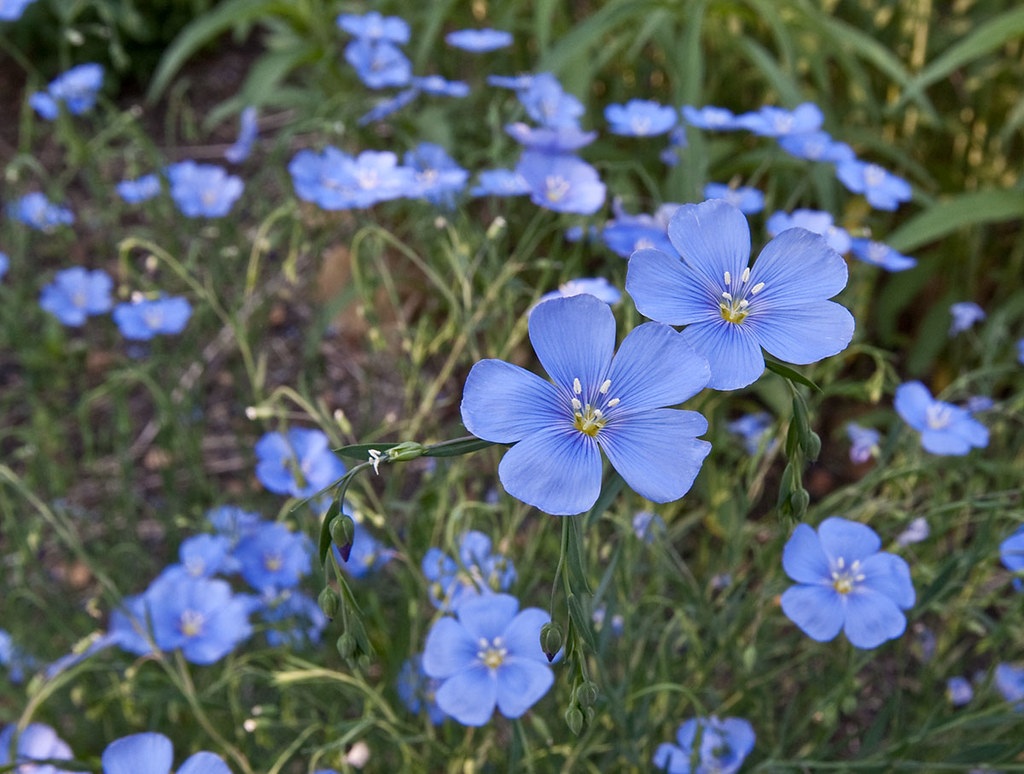
Blue flax (Linum lewisii):
Blue flax is a perennial wildflower native to Western North America with pretty, though short-lived, flowers. The slender stem is fibrous and was used for its fibers by the Native Americans. Primarily pollinated by small bees and flies, its seed is an important food source for gamebirds like sage grouse, as well as deer mice. This drought tolerant species prefers full sun and sandy or rocky soil.
https://www.wildflower.org/plants/result.php?id_plant=lile3
European Honey Bee (Apis mellifera) and California Poppy (Eschscholzia californica)
Photo by Anthony Colangelo, Pollinator Partnership
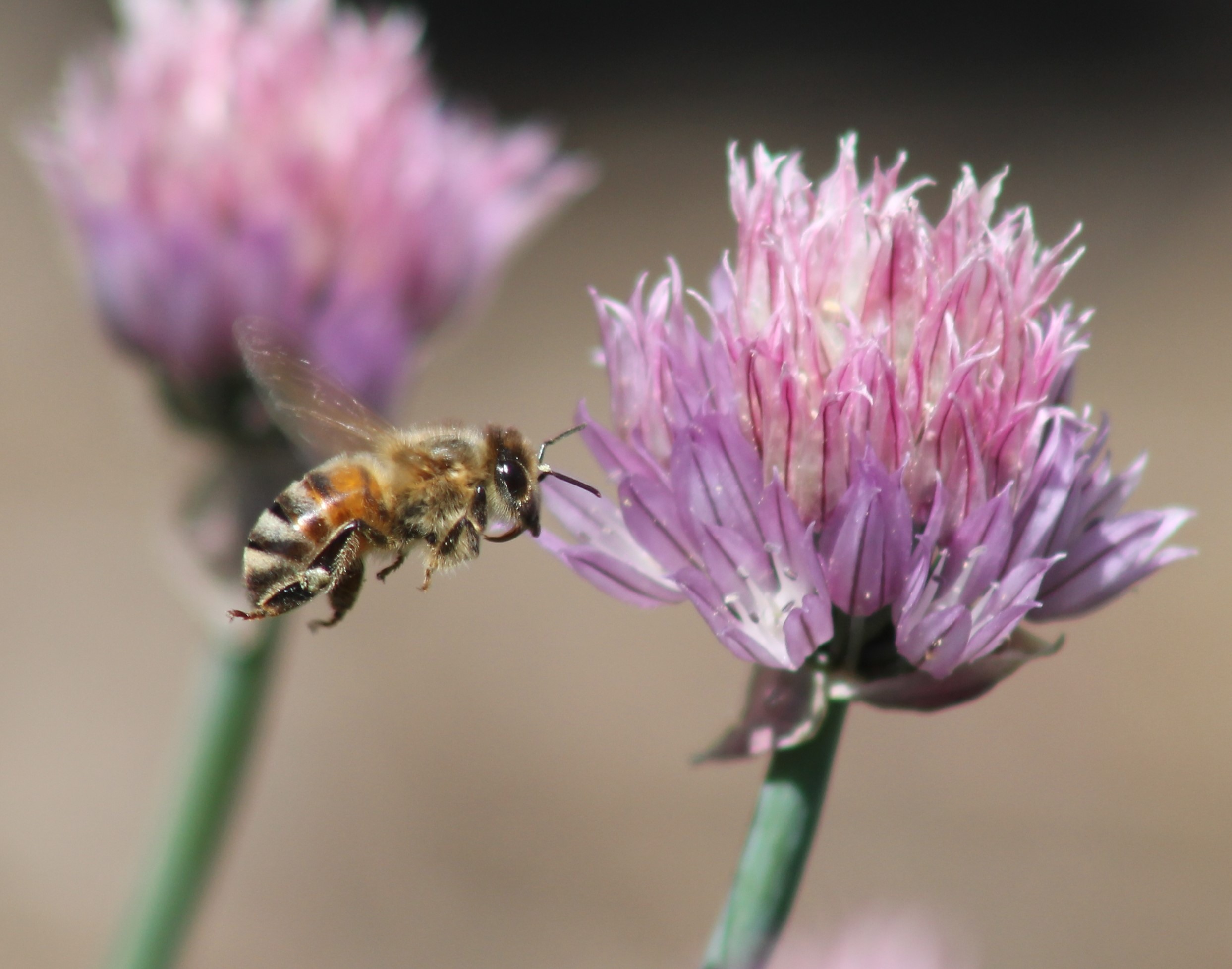
European Honey Bee (Apis mellifera):
The western or European honey bee (Apis mellifera) is one of the most important agricultural livestock in the world, and pollinates about 30% of the world’s food crops. European honey bees were first imported to North America in 1622 and so are not native to this continent, but their influence on US agricultural systems cannot be understated. According to the US Department of Agriculture, Apis mellifera pollinate an estimated $18 billion worth of crops in the US each year, including over 130 different kinds of fruits, nuts, and vegetables. European honey bees are also raised to produce honey and other beeswax products like propolis. Like other kinds of honey bees, Apis mellifera are eusocial insects, meaning they live in colonies that rely on a single fertile female bee, the queen. Apis mellifera colonies can house tens of thousands of bees, each with their own specific roles, that communicate with one another through pheromones and dance language.
https://www.pollinator.org/pollinator.org/assets/generalFiles/NAPPC.HoneyBee.broch.ver5.pdf
https://www.inaturalist.org/taxa/47219-Apis-mellifera
https://www.usda.gov/peoples-garden/pollinators/honey-bees
Photo by Kevin Stanchfield, courtesy of Wikimedia Commons CC BY 2.0
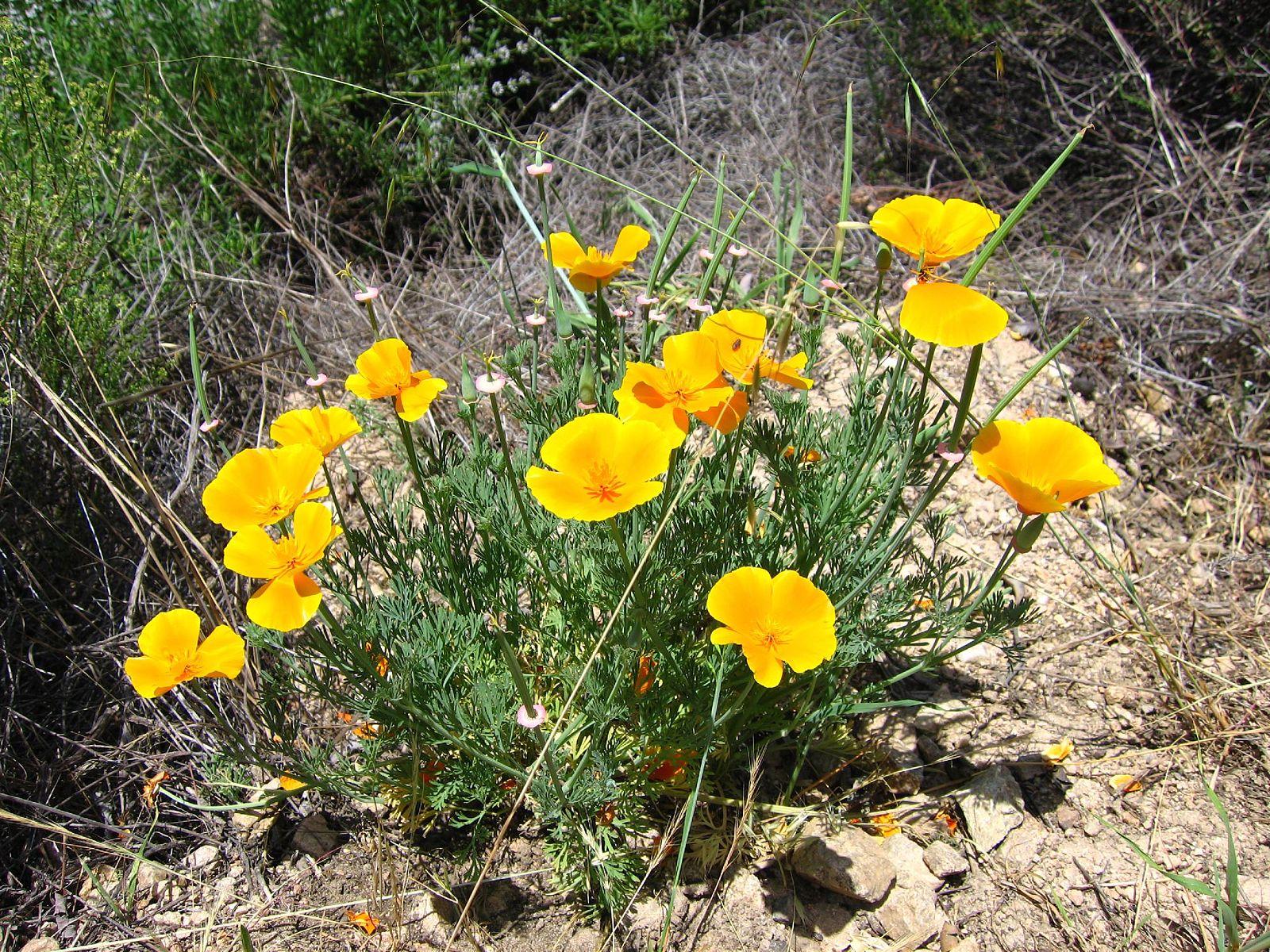
California Poppy (Eschscholzia californica):
The California Poppy (Eschscholzia californica) is the state flower of California and is native to the Western US, down through Baja California. Immediately recognizable by its bright orange to yellow petals that open during the day and close at night, the California poppy is a tough, drought tolerant, and easy-to-grow annual. They bloom from March through October, and support bees, butterflies, moths, and other pollinators. In fact, there are a number of butterfly species that rely on the California poppy as its host plant, including the Acmon blue, Mormon metalmark, and Pacific dotted blue. It prefers sandy, dry, and well-draining soils accompanied by full to partial sun.
https://calscape.org/Eschscholzia-californica-(California-Poppy)
https://www.wildflower.org/plants/result.php?id_plant=ESCA2
Spicebush swallowtail (Papilio troilus) and Wild bergamot (Monarda fistulosa)
Photo by John Flannery, courtesy of Wikimedia Commons CC BY 2.0
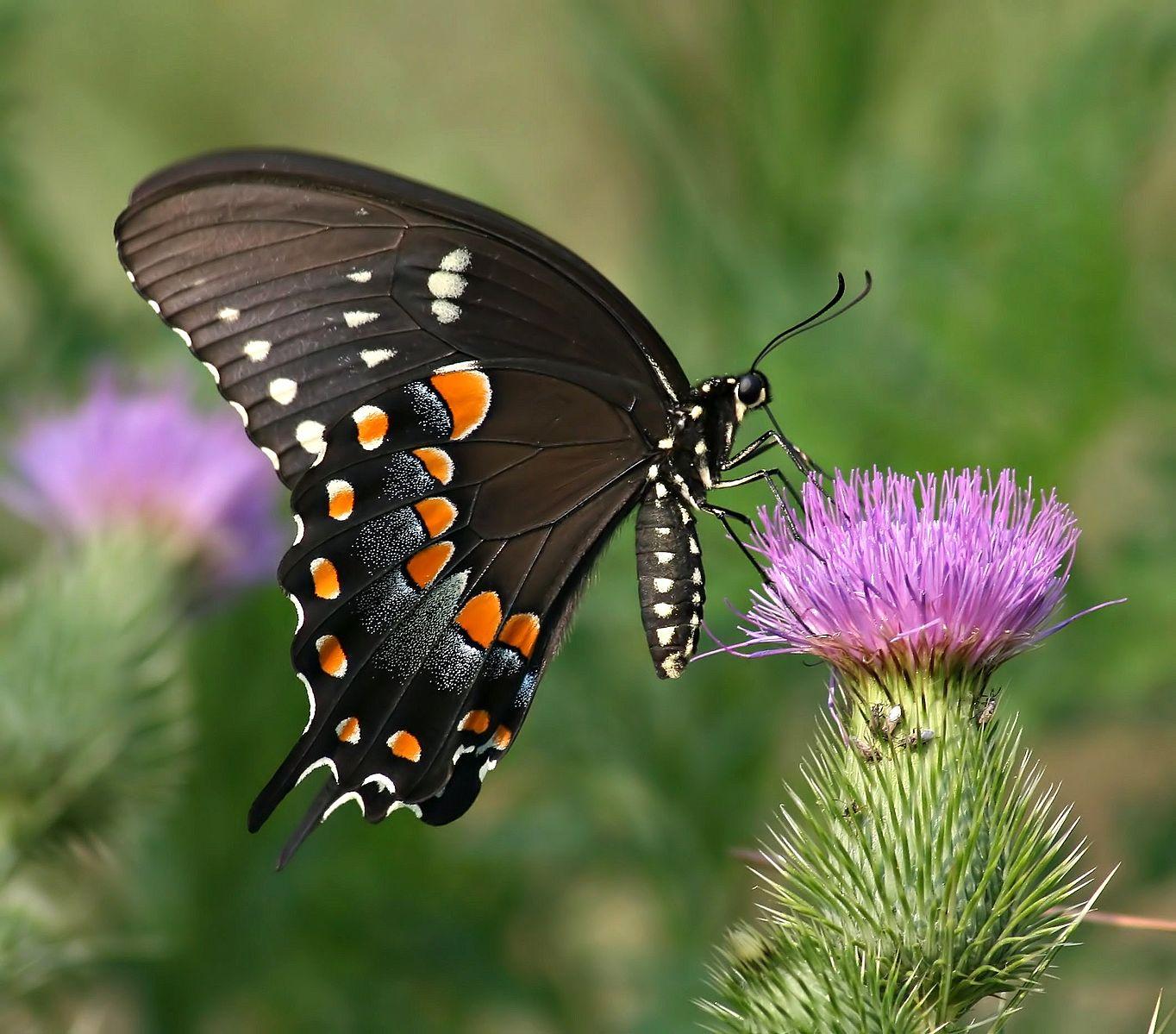
Spicebush swallowtail (Papilio troilus):
Commonly found across the Eastern US from southern Canada south to southern Florida, the Spicebush swallowtail (Papilio troilus) is a large and beautiful pollinator. Made identifiable by its mostly black wings, dotted with yellowish/ivory spots along the lower margins and blueish (for females) or bluish green (for males) coloration in the median portions of the wings, the adult butterflies are nectar plant generalists and feed on plants like jewelweed, milkweed, thistles, dogbane, and wild bergamot, as depicted in the poster. Spicebush swallowtail larvae (or caterpillars) host plants include northern spicebush (Lindera benzoin), sassafras trees (Sassifras albidum), and red bay (Persea borbonia), so consider planting one of these to provide more habitat for these butterflies and their larvae. To avoid predators, spicebush swallowtail caterpillars mimic snakes in their appearance and with their osmeterium or “snake tongue” that unfurls when they are threatened.
https://www.lsu.edu/botanic-gardens/research/CommonButterfliesFoundinthePollinatorGarden.pdf
https://www.butterfliesandmoths.org/species/Papilio-troilus
https://entnemdept.ufl.edu/creatures/bfly/spicebush_swallowtail.htm
Photo by Joshua Mayer, courtesy of Flickr CC BY 2.0
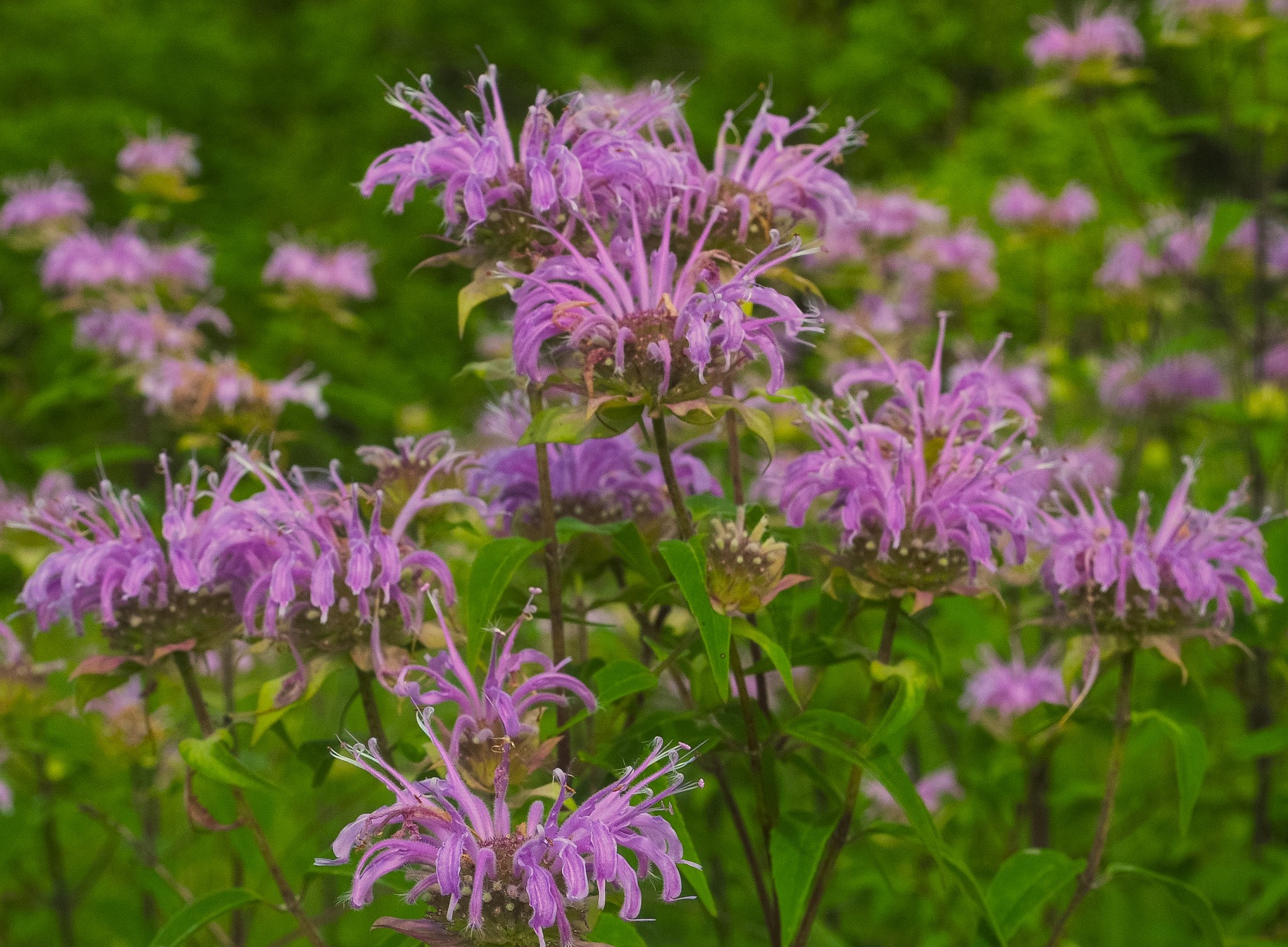
Wild bergamot (Monarda fistulosa):
Native to most of the lower 48 with a few coastal exceptions (California and Florida), wild bergamot (Monarda fistulosa) is a highly prolific nectar plant that can be found in poor, well-draining soils. Characterized by its clustered, two-lipped, lavender-colored flowers, this pollinator-friendly perennial is visited by hummingbirds, bumble bees, butterflies (including the monarch), and hawk moths. Bergamot requires a medium amount of water to get established, blooms from May - October, and can thrive in full sun to partial shade.
https://www.missouribotanicalgarden.org/PlantFinder/PlantFinderDetails.aspx?kempercode=g560
https://plants.ces.ncsu.edu/plants/monarda-fistulosa/
https://extension.umd.edu/resource/wild-bergamot/
Golden northern bumble bee (Bombus fervidus) and Wild Lupine (Lupinis perennis)
Photo by Judy Gallagher, courtesy of Wikimedia Commons CC BY 2.0

Golden northern bumble bee (Bombus fervidus):
The Great northern bumble bee or Bombus fervidus is found throughout eastern North America, with the population concentrated in the Northeastern US. They often nest above ground (although below ground nests have been observed as well) in grassy, open areas like forest clearings or roadsides. Like other bumble bees, Bombus fervidus are social bees, living in colonies consisting of a single queen and female worker bees. Bombus fervidus are known as late-season bumble bees, with new queens and males emerging from colonies in and around mid-late summer. Only the mated queens will overwinter by hibernating underground, and are responsible for finding a suitable location for a nest, laying eggs, and foraging until the new workers first emerge in the summer. Bombus fervidus have long tongues that they use to quickly feed on nectar from plants like asters, common milkweed, blueberry, jewelweed, and goldenrod. Unfortunately, like other bumble bee species Bombus fervidus populations have declined in recent years, but are not considered endangered.
https://wiatri.net/inventory/bbb/resources/SpeciesDetail.cfm?ESTID=11435
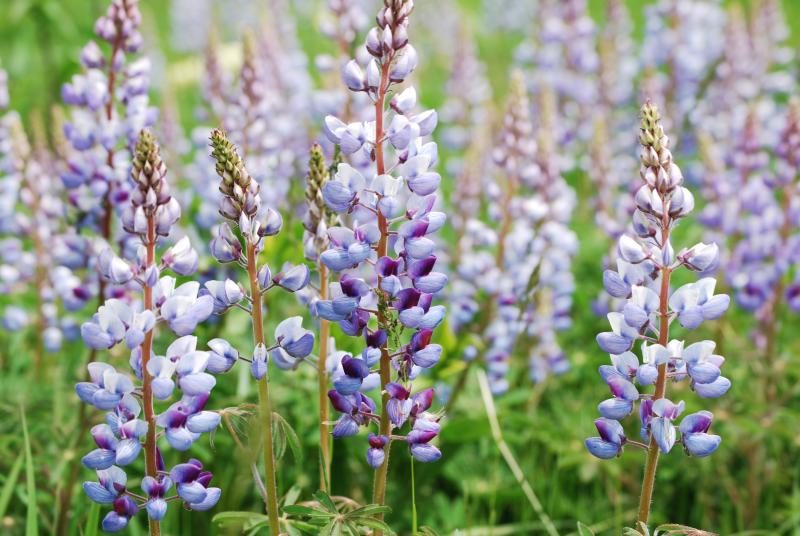
Wild Lupine (Lupinis perennis):
Wild Lupine or Lupinis perennis is a beautiful North American-native perennial wildflower, and can be found in the Eastern US from Texas, northward to Ontario and eastward into Maine. A very hardy perennial, it prefers dry, sandy soils and its nitrogen-fixing ability allows it to adapt to nutrient-deficient soils as well. Characterized by its elongate stems of blueish purple pea-like flowers, Lupinis perennis is the host plant of the federally endangered Karner Blue Butterfly (Lebejus melissa). Along with the Karner Blue, wild lupine is a host plant for the Queen Alexandra's Sulphur (Colias alexandra), Wild Indigo Duskywing (Erynnis baptisiae), Eastern Tailed Blue (Cupido comyntas), Frosted Elfin (Callophrys irus), and the Persius Dusky Wing (Erynnis persius).
https://www.wildflower.org/plants/result.php?id_plant=lupe3
https://www.fs.usda.gov/wildflowers/plant-of-the-week/lupinus_perennis.shtml
Other species depicted on this year's poster:
Photo by James St. John, courtesy of Flickr CC BY 2.0
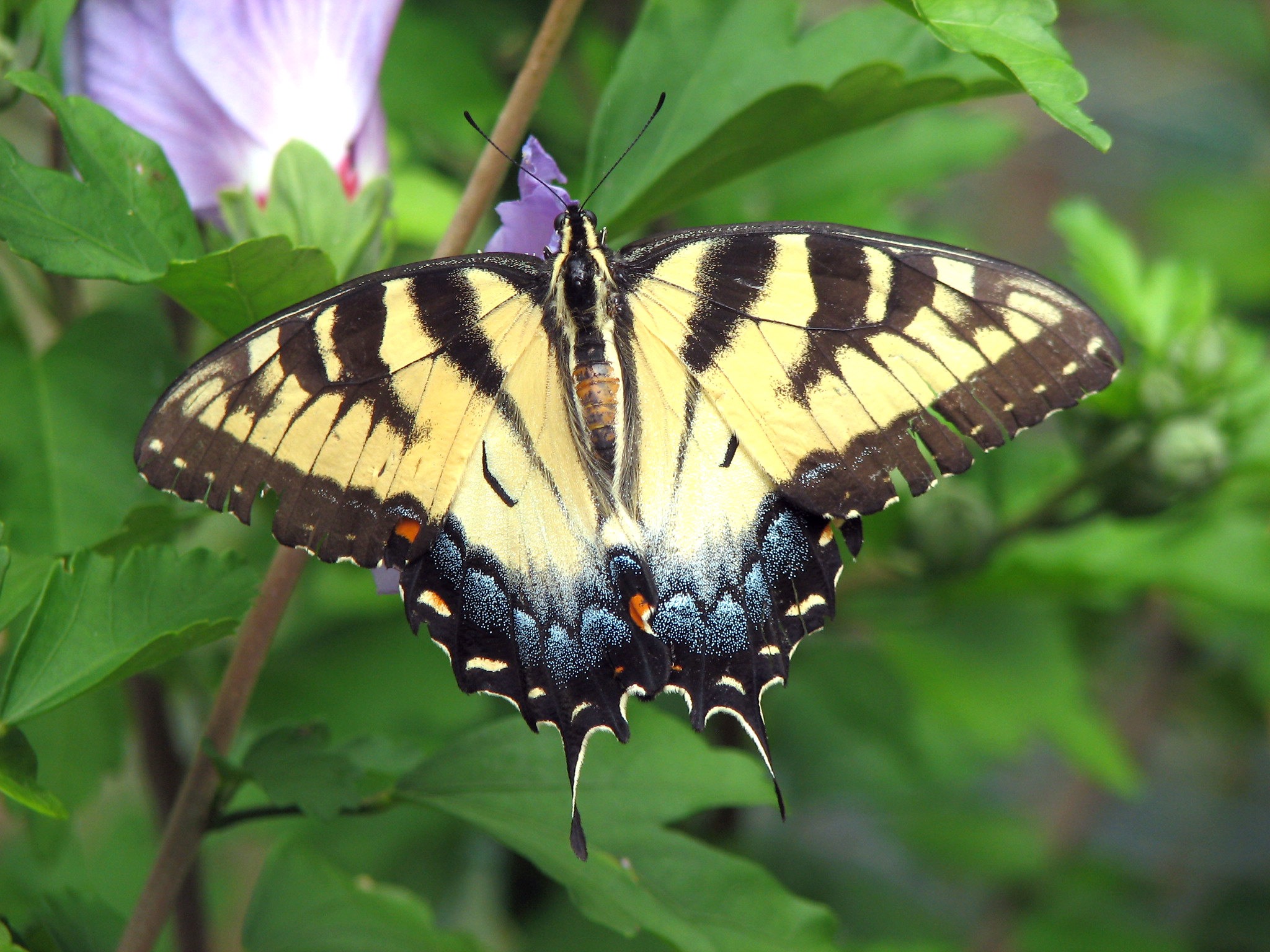
Eastern Tiger Swallowtail Butterfly (Papilio glaucus)
The Eastern Tiger Swallowtail (Papilio glaucus) is a large butterfly with a wingspan of almost 5 inches and is probably the most recognizable swallowtail. It is found throughout eastern North America from Ontario to the Gulf Coast and west to the Colorado plains and south Texas. It is also the state butterfly of Alabama, Delaware, Georgia, and South Carolina. The males are bright yellow with black tiger stripes and the females have 2 forms: one is yellow like the male and the other is black with dark stripes. The hindwing of both female forms has a blue iridescent wash and a band of blue stripes on the lower portion of the wing. The Eastern Tiger Swallowtail uses a variety of host plants to lay eggs upon, including black cherry (Prunus serotina), sweetbay magnolia (Magnolia virginiana), and tulip tree (Liriodendron tulipifera). You might also recognize the caterpillars for their bright yellow, black and blue false eyespots, which are on the thorax behind their true eyes. Once into adulthood, these swallowtails feed on milkweed, wild cherry, lilacs, and New York ironweed (Vernonia noveboracensis) a native of the eastern U.S. which produces clumps of red and purple flowers.
https://www.naba.org/chapters/nabanj/butterflies/eastern_tiger_swallowtail.html
https://www.butterfliesandmoths.org/species/Papilio-glaucus
https://entnemdept.ufl.edu/creatures/bfly/tiger_swallowtail.htm
https://animaldiversity.org/accounts/Papilio_glaucus/
https://www.fs.usda.gov/wildfl...
Photo courtesy of Wikimedia Commons, CC BY 4.0
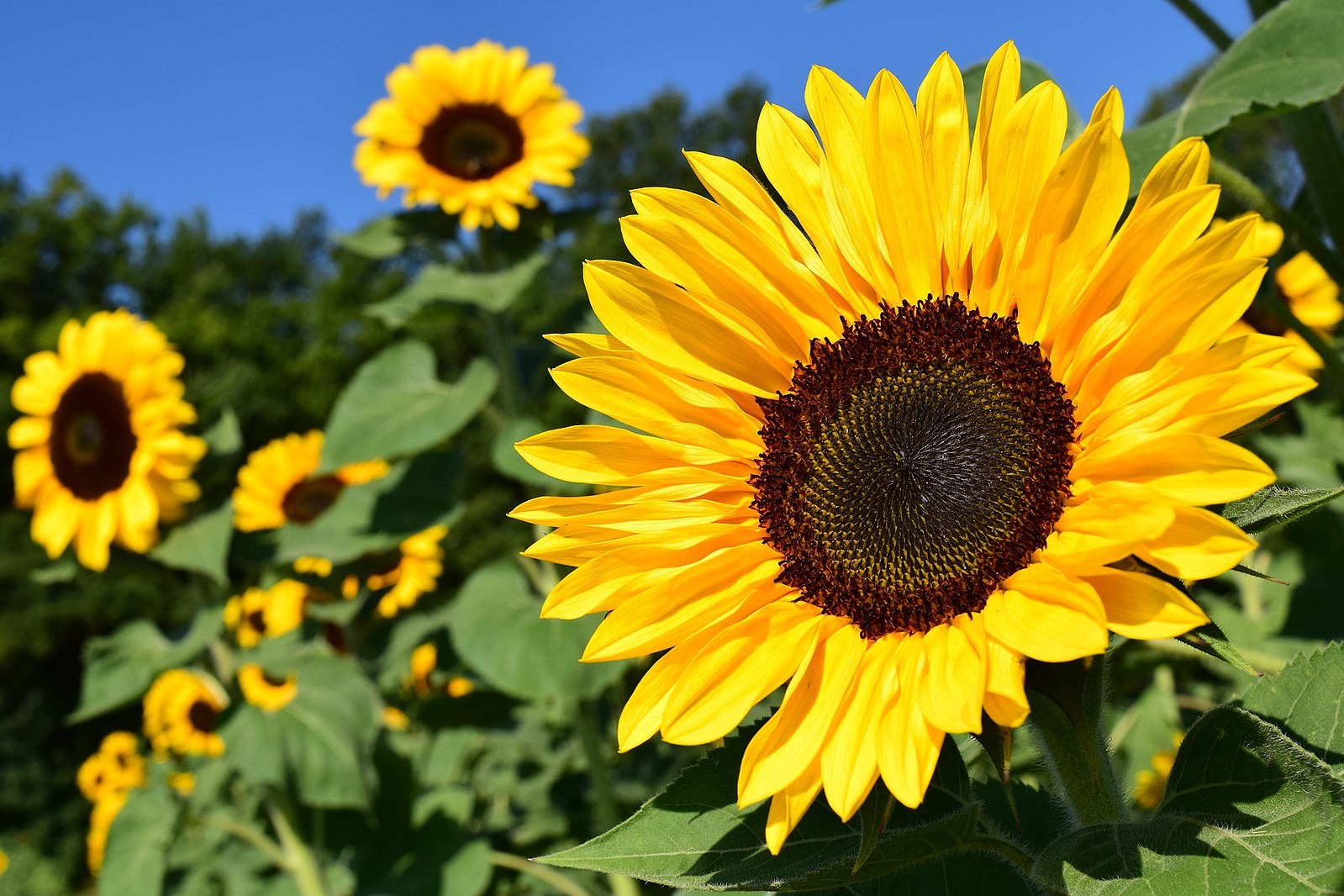
Sunflower
Helianthus spp. refers to a genus of annual and perennial flowering plants commonly known as sunflowers. While many varieties of sunflowers cultivated in agricultural settings for their seeds and oil are self-pollinating, European honey bees and native bee visitation has been shown to increase the fertility of the species. In general, sunflowers prefer disturbed, well-draining, sandy soils along with full sun, and can be an easy-to-grow addition to your pollinator garden in almost every region of the United States.
https://www.wildflower.org/plants/result.php?id_plant=hean3
Photo by John Winder, courtesy of Flickr CC BY 2.0
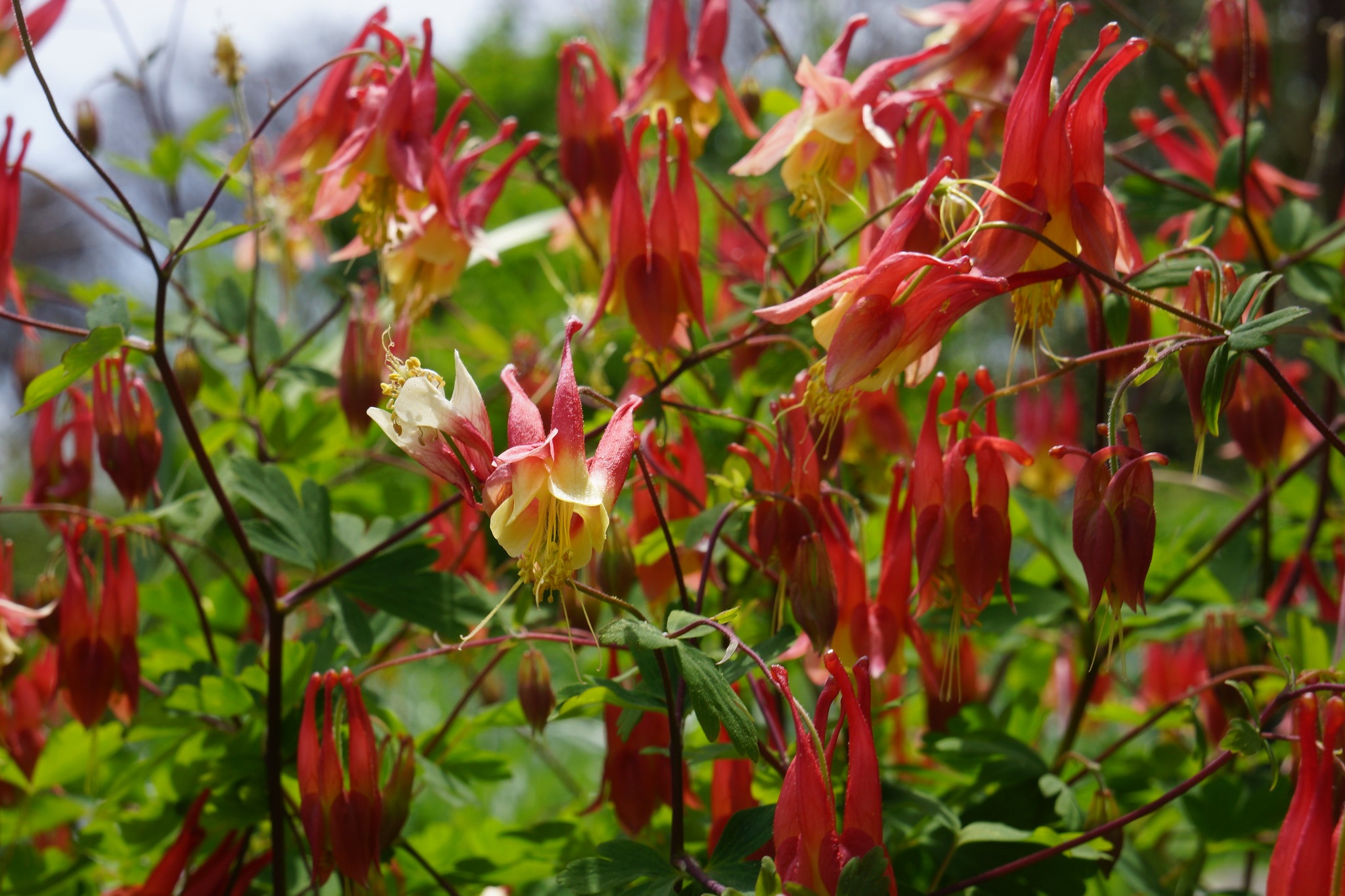
Eastern Red Columbine (Aquilegia canadensis)
Eastern red columbine is a favorite of hummingbirds and long-tongued insects, and with the optimal soil conditions, eastern red columbine is a ready self-seeder. This branching perennial prefers a wide range of soils so long as they’re well-draining, and is adaptable to full sun to shady spots. Host plant for the columbine duskywing butterfly (Erynnis lucilius) and the Pink-tinted beauty (Eosphoropteryx thyatyroides).
https://www.wildflower.org/plants/result.php?id_plant=aqca
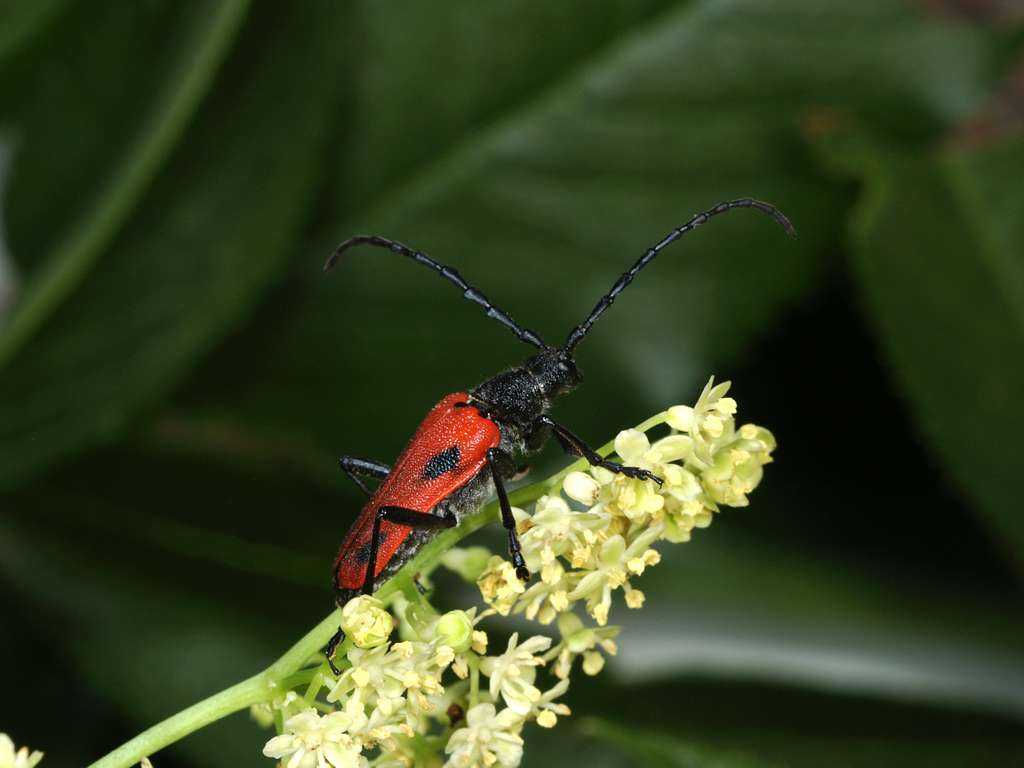
Valley Elderberry Long Horned Beetle (Desmocerus californicus dimorphus)
Listed by the US federal government as an officially threatened species, the valley elderberry long horned beetle (Desmocerus californicus dimorphus) is native to the California Central Valley. Its coloration varies between the male and female species. The male is distinguished by primarily red forewings with dark green spots, whereas the female forewings are dark green with red margins. The species is entirely dependent on the elderberry shrub (Sambucus spp.) throughout its entire life cycle. The adult beetles emerge from holes in the elderberry trunk as the plant begins to bloom. From there, the beetles feed on the elderberry’s leaves and flowers until around June when their mating season begins. Their “messy” foraging behavior will dislodge and transfer pollen between the elderberry flowers, which helps with seed fertilization. The females will lay their eggs in the bark of the elderberry.
https://www.fws.gov/species/valley-elderberry-longhorn-beetle-desmocerus-californicus-dimorphus
https://ecos.fws.gov/ecp/species/7850
Photo by Melissa McMasters, courtesy of Wikimedia Commons CC BY 2.0
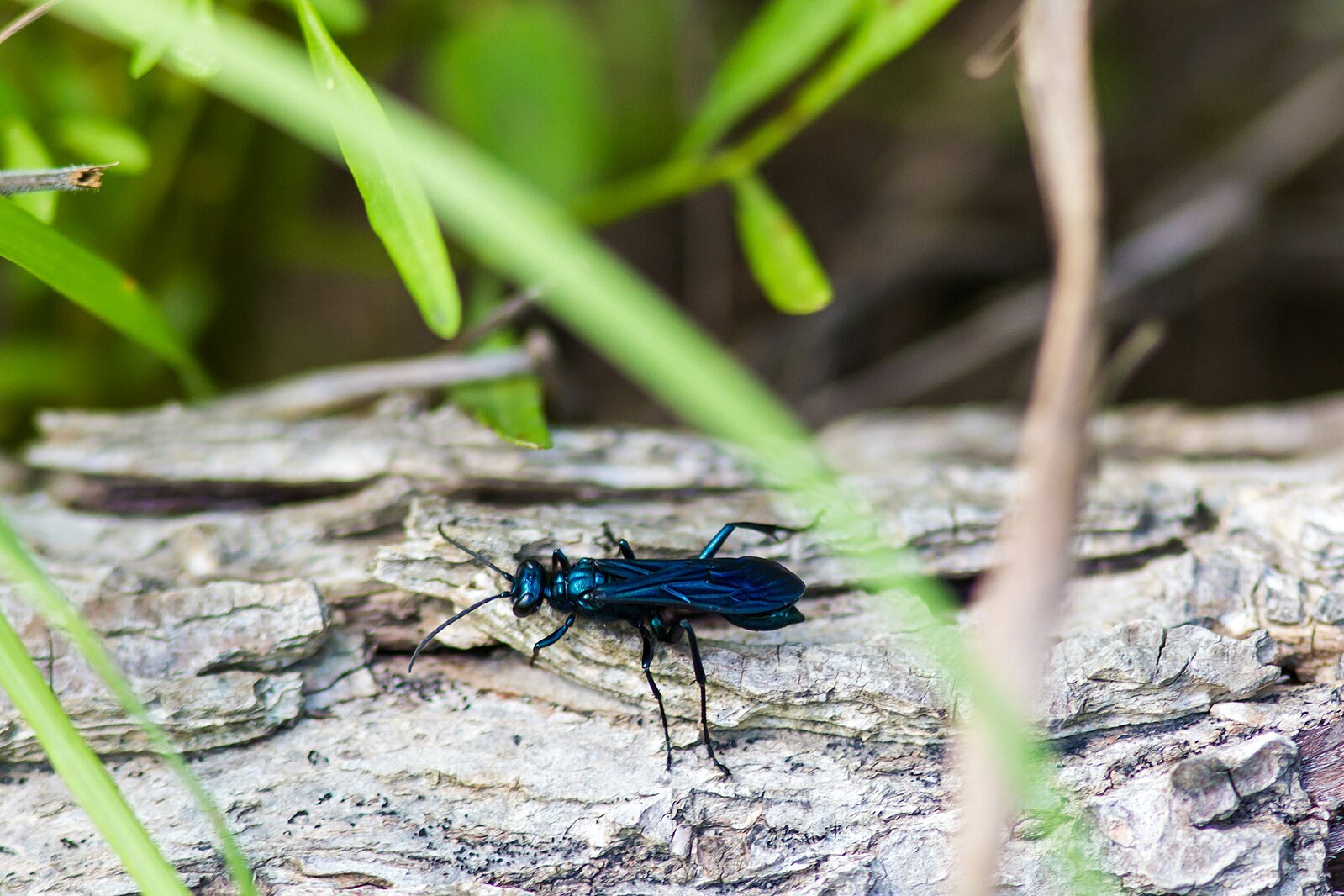
Blue Mud Wasp (Chalybion californium)
The Blue mud wasp, black widow killer, or Chalybion californium is a large and distinct wasp, made recognizable by its blue and black sheen. The size of males range from 3/8in.-1/2in. and are typically smaller than the females at 3/4in.-7/8in. Its range extends from Northern Mexico to Southern Canada, although it is most common in the Michigan area. Despite the fact that the Blue mud wasp is most famous for its predation of the highly venomous black widow spider, it is known to be an important pollinator of some common wildflowers like barberry, wild carrot, and golden alexander. The adults feed on flowers while they feed a more protein-rich diet to their larvae, namely spiders like the black widow. Blue mud wasps are not considered to be aggressive species, although will on occasion sting humans if provoked.
https://animaldiversity.org/accounts/Chalybion_californicum/
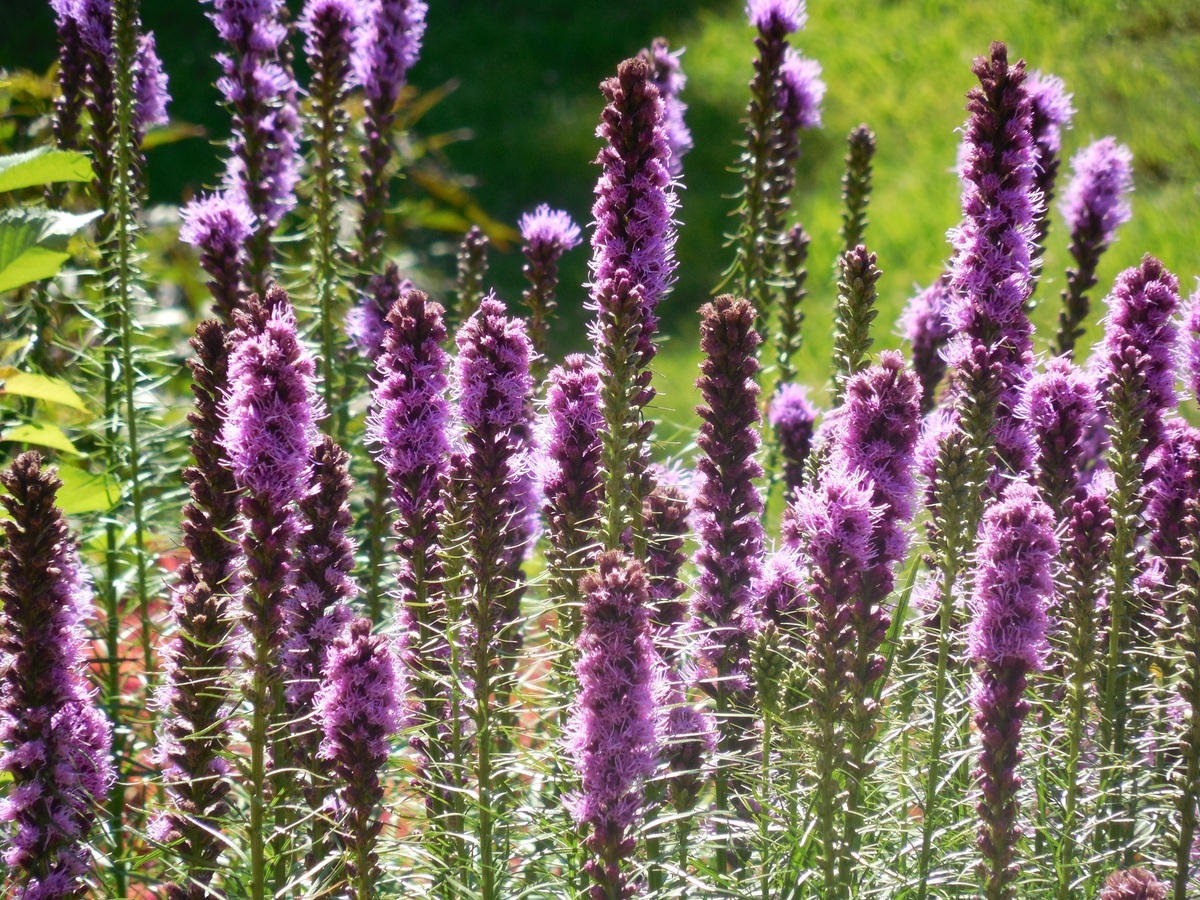
Prairie blazingstar (Liatris pycnostachya):
A plant that Monarch butterflies cannot get enough of, prairie blazingstar is an amazing source of nectar for Monarchs and other butterfly species. Native to North America, prairie blazingstar is one of nearly 50 species of blazingstar found within the region. Identifiable by its purple flowers, spiky stems, and grass-like foliage, this plant thrives in open areas that get plenty of sun exposure.
https://www.wildflower.org/plants/result.php?id_plant=LIPY
Science Advisors

Dr. David Inouye has worked on pollinator ecology and conservation for many years, and been an active participant in NAPPC since its inception and currently serves as the Chair of the NAPPC Steering Committee. He continues his work on pollinators each summer at the Rocky Mountain Biological Laboratory.

Dr. Gary Krupnick is the head of the Plant Conservation Unit in the Department of Botany, National Museum of Natural History at the Smithsonian Institution in Washington, D.C. His research examines how data from herbarium specimens can be used in assessing the conservation status of plant species. Gary serves on the Steering Committee of NAPPC.
Dr. Lora Morandin has been doing research on bees and pollination since 1997. She started out working on bee pollination of greenhouse tomatoes at Western University in Ontario and that grew into an interest in native pollinator conservation and sustainable agriculture. She then did a PhD at Simon Fraser University in British Columbia studying modern agriculture and pollinators, followed by post-doctoral research at the University of California, Berkeley working on enhancement of native pollinators and natural enemy insects through small-scale farm restoration. Lora has co-authored books and book chapters, created outreach and technical guides, and has about 30 peer-reviewed publications on pollinators and sustainable agriculture, including innovative work on economic benefits of ecosystem services. She has consulted for government and industry on diverse ecological topics such as greenhouse coverings, seabird oiling from offshore oil and gas operations, and honey bee health research gaps. One of her main interests is finding ways that human land-use, production, and conservation can co-exist for a healthy and sustainable environment. Lora lives in Victoria, British Columbia and when she’s not working she spends time on her urban farm, with her family and pets, and enjoying BC’s beautiful natural areas.
